 04/04/2012 10:45 04/04/2012 10:45 |
|
| | | OFFLINE | | Post: 24.598
Post: 7.132 | Registrato il: 28/08/2005
Registrato il: 20/01/2009 | Administratore | Utente Master | |
|



 Perhaps it's time to classify the Archbishop of Vienna among the dissident bishops. This commentary by Paolo Rodari on the aristocrat-Cardinal's latest 'accommodation' towards the unorthodoxies of his flock seems to support the inevitable conclusion. And seems to underscore that Schoenborn's dissidence must sooner rather than later require the Pope's intervention.
Perhaps it's time to classify the Archbishop of Vienna among the dissident bishops. This commentary by Paolo Rodari on the aristocrat-Cardinal's latest 'accommodation' towards the unorthodoxies of his flock seems to support the inevitable conclusion. And seems to underscore that Schoenborn's dissidence must sooner rather than later require the Pope's intervention.
Otherwise, way to go, Christoph! - if you're really trying hard to establish your creds as the ultimate anti-Ratzinger in the next Conclave, though I think you seriously 'mis-underestimate' the weight and influence of the genuinely Ratzingerian cardinals now in the College...
Schoenborn now outdoes Cardinal Martini
in support of same-sex unions
by Paolo Rodari
Translated from

April 3, 2012
"I decided for the people, not against the people, to whom I have given my autonomous consent".
Thus did Cardinal Christoph Schoenborn, Archbishop of Vienna, defend himself yesterday on Austrian state TV, for his decision to confirm Florian Stangl as the head of the pastoral council of Stuetzenhofen, north of Vienna.
Who is Stangl? Just another Catholic, except that he is a homosexual who is officially registered as being in a union with another man.
In Austria, it's all the buzz these days. The newspapers are all praising the 'generous cardinal' who despite the vibrant protests of Catholic groups usually defined by the media as 'traditionalist', has 'opened the Church to the future'.
Among the few who oppose Schoenborn's move is the parish priest of Stuetzenhofen, Fr. Gerhard Swierszek. He had asked for Schoenborn's intervention to invalidate Stangl's election by the parishioners as head of the parish council, expecting to get his bishop's support. Well, he didn't.
Before announcing his decision, Schoenborn invited Stangl and his companion to lunch, after which he announced: "Now I understand why the community of Stuetzenhofen elected him. He is an impressive personality, a humble man of great faith". [How can 'a man of great faith' cheerfully violate Church teaching and decide to 'live in sin'? Not to be prudish, but the Church does ask homosexuals to be chaste. Perhaps, as I remarked earlier, Stangl convinced Schoenborn that he was in a chaste relationship with his partner, and so he has the Cardinal's blessing. If that is the case, Schoenborn should say so, and Stangl and his partner can be properly considered a model for other Catholic homosexuals.]
Schoenborn added: "I know the rules, but I also know that Jesus came for man, not for the rules. I think this young man is in the right place and therefore, I approve his election". [Of course, Jesus forgives us every time we sin and ask his forgiveness. Are we to understand then that Stangl regularly confesses his transgression, knowing full well he will keep on transgressing? Or perhaps, he does not confess it at all, because he does not think it is a transgression. In any case, his equivocal situation raises problems that may well trouble simple parishioners who take the idea of sin seriously.]
This story has revived the words that Cardinal Carlo Maria Martini wrote recently in Corriere della Sera about gay unions: "It is not bad, in place of occasional homosexual (sex) encounters, that two homosexuals should decide on a certain stability which the state should facilitate". [The Jesuit cardinal is, of course, being classically jesuitic in expressing himself. He is saying, in short: "The state should legalize gay marriage because it is better than having homosexuals simply indulge serially in random promiscuous sex".]
For many Austrians, legalized gay marriage is what Schoenborn is ultimately 'aiming for'. In 2010 he had declared, "On the issue of homosexuality, one must consider the quality of the relationship and if (this is genuine), we can speak about it with appreciation".
[Let's see: In the past few years, Schoenborn has manifested concretely that
1) he sanctions 'funny Masses' - including people picnicking, drinking beer and smoking while a priest is saying Mass for them - and he even celebrates them;
2) he sees nothing wrong with the Cathedral Museum of Vienna displaying secular art that blasphemes Jesus by depicting the Last Supper as a homosexual orgy;
3) he agreed with other Austrian bishops in denouncing the Vatican's - i.e., the Pope's - process for nominating bishops, when he joined them in rejecting the appointment of a conservative auxiliary bishop to Linz (he was for it before he was against it, as John Kerry would say, having written a most flattering letter in support of Mons. Wagner before the liberal assault against him began). [The same Austrian bishops' statement in 2010, by the way, also included disapproval for the lifting of excommunication from Bishop Williamson];
4) he believes in the Marian apparitions in Medjugorje against diocesan Church findings in the past 30 years, and without waiting for the conclusion of the Pope's Medjugorje commission, to the point of inviting a couple of the 'seers' to 'host an apparition' in St. Stephen's Cathedral;
5) he has declared that it is high time the issue of priestly celibacy was re-examined;
and now this.
Schoenborn's teaching authority in Vienna is not easy. He has had to deal with the so-called 'Pfarrerinitiativ' by 300 Austrian parish priests who demand priestly and lay co-control of Church affairs; ordination of women as priests; communities to celebrate their own forms of the Eucharist; abolition of priestly celibacy; full acceptance of homosexual activity; and giving Communion to anyone who wants it . [But that initiative has not grown much beyond the 300 priests who started it in 2006 - a tenth of Austria's parish priests, it is true. Yet, a true bishop does not start bending the rules to accommodate those who would want to change the very structure of the Church - he ought to stand up firmly and unequivocally for what the Church teaches, as Benedict XVI does, and as he ought to do if he truly respects the Pope.]
And the Vatican? For now, it seems to be merely observing things, but it is said that, it is silently contemplating countermoves. [Who is 'it'? Only the Pope's actions matter in this regard. It's hard to imagine him having a blind spot about Schoenborn's dissidence just because the latter is supposed to be a 'favorite'! After all, he put his foot down when Schoenborn made unsupported public allegations about Cardinal Sodano, even if Schoenborn made those allegations in the act of ostensibly 'defending' Cardinal Ratzinger in the matter of how the Vatican had handled sex abuse allegations against Schoenborn's predecessor as Archbishop of Vienna.
In any case, such open dissidence is most unseemly from someone who is President of the Joseph Ratzinger/Benedikt XVI Foundation (the formal corporation of the Ratzinger Schuelerkreis), which Schoenborn is. But he obviously sees no fundamental contradiction in his expressions of dissent against the Magisterium and his position in the Foundation, not to mention the inevitable appellation that MSM tack on to his name, 'a protege and confidant of Benedict XVI', and the fact that he is a member in long standing of the Congregation for the Doctrine of the Faith!
Please, Holy Father, far be it from me to second-guess you! You always know best, but please do something soon about your wayward protege. It's not as if 'he knows not what he is doing'. It matters a lot as an example for the Church, because last year, you dismissed an Australian bishop for similar manifestations of dissidence over a number of years. You once famously said that the worst bishop is someone who would rather compromise than confront issues directly and displease anyone [other than the Church herself, obviously].
Yet, is that not what Schoenborn has been doing - and with apparent impunity? And what makes his disregard for certain aspects of the Magisterium - traditional ones at that - less objectionable than the Lefebvrians' objections to Vatican II?]
P.S. I didn't realize till just now that Andrea Tornielli also wrote on this the same day in VATICAN INSIDER, which provides more details on the story that make Schoenborn's action and statements even more outrageous! READ, WEEP AND GNASH YOUR TEETH! {I am not outraged about Stangl or the lifestyle he chose, because that's his personal responsibility. I am outraged that the Archbishop of Vienna should put his stamp on cafeteria Catholicism as he does in this episode.]
Cardinal Schoenborn justifies
why he ratified the election
of a practising homosexual to
a parochial pastoral council
by Andrea Tornielli
Translated from

April 3, 2012
A young Austrian man who lives with a male companion, and who has registered this union as required by Austrian law, was elected by a great majority to the pastoral council of the parish of Stuetzenhofen in northern Vienna.
And Cardinal Christoph Schoenborn, Archbishop of Vienna, has ratified the election against the objection of the parish priest.
The pastoral council is an institution defined in the Canon Code that aims to have parish members take part in programming the life of the parish.
Stangl obtained 96 votes out of 142, but his parish priest, Fr. Gerhard Swierzek, asked him to give up the position, just as he had previously asked him not to present himself for communion because he was living openly with another man.
"I feel bound to the teachings of the Church," Stangl replied, "but the demand to live in chastity seems unrealistic to me". [A 'rationalization' typical of cafeteria Catholics. Cardinal Schoenborn's subsequent open praise of Stangl, whom he confirmed in the council position, is nothing less than an open endorsement of cafeteria Catholicism - that Catholics can pick and choose to follow only what is convenient for them. As a simple Catholic who tries to follow what the Church teaches the best way I can, I don't care what philosophical subtleties Schoenborn may dredge up to justify his position, but he is certainly not defending the faith by giving his blessing to do-as-you-please Catholicism, and that is no way for a bishop to behave.]
At first, the Archdiocese of Vienna said that the fact of being in a registered same-sex union does not allow Stangl's perticipation in a pastoral council. Stangl then asked for an audience with Cardinal Schoenborn who invited him and his companion for lunch.
After the meeting, the cardinal published a new statement, admitting that "there are many members of parochial pastoral councils whose lifestyle does not always conform to the ideals of the Church, but whose commitment to seek to live a life of faith must be appreciated". [Translation: You may be living in a state of chronic sin, but you can be held up as a model nonetheless.]
He went on to praise the participation of Stangl in the life of his parish, pointing out that " formal errors which emerged during the election do not place in question the results of the election in which the youngest candidate, Florian Stangl, received the majority of the votes".
[NB: Nothing changed objectively from the time the diocese said Stangl's registration as a partner in a same-sex union disqualified him from being a member of the parochial council. Only Schoenborn's subjective opinion changed, ignoring the rule that was the basis for the earlier diocesan objection, simply because the cardinal came out of his meeting with Stangl and his partner convinced he was otherwise a good man and therefore deserved to be qualified.]
The cardinal goes on to say he was "profoundly impressed" by Stnagl's faith, "by his humility, and the way in which he conceives his service" [to the Church], and that he understood why his fellw parishioners "voted so decisively for his membership in the council".
His final decision was therefore not to invalidate the voting results " even if the rules have to be revised to clarify the requirements for candidates to the pastoral council".
The 'formal errors' cited by Schoenborn have to do with the fact that candidates for pastoral councils in the diocese should sign a statement affirming their "adherence to the faith and discipline of the Catholic Church", which condemns as sinful the practice of homosexuality and opposes recognition of same-sex unions. The candidates for the parish council in Stuetzenhofen did not sign such a statement. [There is a reason why rules are set up. Making arbitrary exceptions to a rule is not only capricious and undisciplined, but sets precedent and provides the slippery slope for eventual nullification of the rule.]
In recent days, Cardinal Carlo Maria Martini, emeritus Archbishop of Milan, has indicated his openness to civilian same-sex unions. In the interview-book Credere e conoscere [To believe and to know) with Ignazio Marino, the cardinal, after stating the need to defend the family based on matrimony between a man and a woman, said: "But it is not bad that, in place of occasional homosexual relationships, two persons should have a certain stability, and therefore, in this sense, the State could facilitate it".
The current Archbishop of Milan, Cardinal Angelo Scola, thinks differently. Interviewed in connection with the coming World Encounter of Families in Milan, where the city council is prposing a registry for de facto unions (hetero- or homosexual), said: "The term family should not be used for other forms of cohabitation. To insist on using it otherwise is confusing and will end up making the precious constitutive factors of a true family empty of meaning".
Schoenborn surely knows that with everything he has been doing - words and actions few other dissident bishops have matched for daring and for persistence - he is compromising not just the Church and Catholicism itself, but also Pope Benedict XVI, who is universally considered to be particularly linked to him because of the Schuelerkreis. And that this is all counter-productive to Benedict XVI's scrupulous orthodoxy.
In the greater context of Schoenborn's open liberalism, the following detail may be insignificant: He was never properly a pupil of Prof. Ratzinger, as he already had his doctorate in theology from the Sorbonne when he decided to audit Prof. Ratzinger's classes in Regensburg for a semester (or a year? - I am unable to find the online source from which I learned this a few years back). [4/6/12 P.S. I found the source - Fr. Vincent Twomey, who studied at Regensburg from 1970-1978 and obtained his doctorate under Prof. Ratzinger, was correcting John Allen's 2005 erroneous description of Schoenborn as a 'student of Ratzinger'. This is what Twomey wrote: "(While a visiting scholar in Regensburg, Schonborn joined our colloquium [Prof. Ratzigner's doctoral class] for two semesters, as did other visitors. (i.e., they attended the sessions but were not registered for the class). It was only after Ratzinger's elevation as Archbishop of Munich, that Professor Schonborn became one of a number of regular guests at the annual meetings of the Schulerkreis".
Regardless, surely this monster bishop whose liberal tendencies are building up alarmingly and setting a terrible example in the Church cannot be the man whom Cardinal Ratzinger assigned to be the chief editor of the Catechism of the Catholic Church.
[Modificato da TERESA BENEDETTA 06/04/2012 16:29] |
| |
|
| |
 04/04/2012 12:17 04/04/2012 12:17 |
|
| | | OFFLINE | | Post: 24.599
Post: 7.133 | Registrato il: 28/08/2005
Registrato il: 20/01/2009 | Administratore | Utente Master | |
|

 And now, Cuban state TV will also
And now, Cuban state TV will also
broadcast Cardinal Ortega's
Good Friday message to the faithful
Translated from the Italian service of

April 3, 2012
With the churches filled with people, Cubans began Holy Week in a more relaxed atmosphere. Not only was the announcement made that this Good Friday would be a holiday in Cuba, but it was also announced that Cardinal Jaime Ortega, Archbishop of Havana, will present a Good Friday message on state television, something that has not happened in over 50 years.
In Latin America, where the days before Easter are days off work in most countries, Good Friday itself is marked with particular religious fervor. On this day, great attention is given to the so- called 'Seven Last Words' of Jesus on the Cross.
All the bishops and parish priests prepare intensely for these Good Friday sermons on the 'Seven Last Words' which are followed by the faithful not just in churches but also on radio and TV.
The decision to have the Havana cardinal's Good Friday message transmitted on Cuban state TV followed President Raul Castro's decision to declare this Good Friday a holiday, in response to Pope Benedict XVI's request made during his recent visit to Cuba.
|
| |
 04/04/2012 15:44 04/04/2012 15:44 |
|
| | | OFFLINE | | Post: 24.600
Post: 7.134 | Registrato il: 28/08/2005
Registrato il: 20/01/2009 | Administratore | Utente Master | |
|
 I was reading a couple of Italian commentaries today reviving the Emmanuela Orlandi kidnapping case that strikes me as a case of Holy Week opportunism - the theory held by some American Catholic commentators that MSM always manage to come up with some bombshells to throw at the Church or the Vatican during Holy Week, as a way of holding up Christianity to ridicule just when the Christian world is celebrating the founding mystery of the faith.
I was reading a couple of Italian commentaries today reviving the Emmanuela Orlandi kidnapping case that strikes me as a case of Holy Week opportunism - the theory held by some American Catholic commentators that MSM always manage to come up with some bombshells to throw at the Church or the Vatican during Holy Week, as a way of holding up Christianity to ridicule just when the Christian world is celebrating the founding mystery of the faith.
But I see the London Telegraph has some version of the story which does give the basic background. I have posted a couple of times before about this long-running 'Vatican mystery' since the coals were raked over last year by the brother of the kidnapped teenager, who organized an online write-in campaign demanding that Benedict XVI reopen the investigation into the crime and disclose everything that the Vatican knows about the case.
Of course, this is another one of those 'scandals' being laid at the door of Benedict XVI even if he had nothing whatsoever to do with the case. The Corriere commentary seems like an attempt to force him to 'reopen' the case, saying he ought to throw light on it as he did on the sex abuse cases against priests. But the latter was within his control and competence to do. In the Orlandi case, if no one could get an answer from the Vatican in all those 21 years during John Paul's time, what are the chances that anyone who does know anything about it would open up now for Benedict XVI? And if any re-investigation comes to the same dead end, everyone will still say anyway that the Vatican is indulging in its 'usual cover-up'.
Raking over long-banked embers:
Vatican accused of cover-up over
teenager's 1983 disappearance
By Nick Squires, Rome

03 Apr 2012
Prosecutors in Rome say that “someone in the Vatican” knows the fate of Emanuela Orlandi, the 15-year-old daughter of a Vatican employee who vanished in June 1983.
Her kidnap in Rome by unidentified men has been the subject of scrutiny for three decades, with allegations that it was connected to blackmail and banking scandals involving the Holy See.
One theory is that the girl’s father, a Vatican employee, had stumbled on documents that connected the Vatican’s bank with organised crime in Rome and that she was seized in an attempt to silence him. The alleged mastermind of the kidnapping was Enrico “Renatino” De Pedis, the leader of the Magliana gang, Rome’s most ruthless criminal band.
He was shot dead by rival gangsters in a street in central Rome in 1990 and his body interred in a crypt in the Basilica of Sant’ Apollinare. It has always been seen as highly unusual that a known mafioso should have been given the honour of being buried in a church in which popes and cardinals are interred.
There has been speculation that Miss Orlandi was murdered and her remains hidden in the tomb alongside De Pedis.
Prosecutors in Rome have for the first time explicitly pointed the finger at the Vatican, saying that senior cardinals are covering up the truth.
Giancarlo Capaldo, a senior prosecutor who is investigating the case, said he had found evidence that serving members of the Curia — the Vatican’s governing body — knew much more than they were saying about Emanuela’s disappearance.
“There are people still alive, and still inside the Vatican, who know the truth,” the prosecutor was quoted as saying by Corriere della Sera.
[I find this a fishy attempt to try and implicate Benedict XVI somehow in this supposed cover-up, since he came to the Vatican in 1982 and would therefore have been in the Curia at least a year when the kidnapping took place. But he was notorious during all his time in the Curia as being a loner, who was never part of any cabal or faction in the Curia. In fact, his only apparent contact in the 'inner circle' was John Paul II himself, and he was never intimate with either Cardinal Sodano nor then Mons. Dsiwisz.]
Pietro Orlandi, Miss Orlandi’s brother, seized on the remarks, saying it was time for the Vatican to come clean and calling on investigators to open the tomb of De Pedis to establish whether it contained his sister’s remains.
“The Holy See now has a moral duty to give a response after refusing for years to collaborate with the magistracy,” he said. “Their silence is becoming embarrassing.”
The Vatican insists that it has divulged all it knew about the case. “If someone on the inside had known something, they would have said,” said Cardinal Giovanni Battista Re, 78, who was number three in the Vatican Secretariat of State at the time. “We were all interested in clarifying the matter, but unfortunately we were not able to find out anything about it.”
[The #1 man at State at the time was Cardinal Agostino Casaroli (who died in 1998), John Paul II's Secretary of State from 1979-1990, who was suceeded by Cardinal Angelo Sodano. It was however, Sondao's first job at the Vatican itself. His previous career since 1959 had been spent in Apostolic Nunciatures abroad, and he was Nuncio to Pinochet's Chile from 1977 to 1988, when John Paul II named him deputy Secretary of State for relations with states, moving him up to Secretary of State when Casaroli retired in 1990. I haven't figured out a way to find out who were the other principal members of the Curia in 1983, but some Vaticanista should be able to come up with that so we can see who among them, other than Cardinal Re, are still around.]
Over the years it has been claimed that Emanuela’s kidnapping was carried out on the orders of a Catholic archbishop, Paul Marcinkus, the disgraced head of the Vatican bank, the Istituto per le Opere di Religione. [He wasn't exactly disgraced. After the IOR scandal, John Paul II named him Governor of Vatican City State, a job he kept till 1990, when he retired.] The IOR was involved in the bankruptcy of Italy’s largest private bank, the Banco Ambrosiano, in 1982.
Its president, Roberto Calvi, nicknamed “God’s Banker”, was found hanged beneath Blackfriars Bridge in London, with investigators unable to rule whether he had committed suicide or was murdered, possibly by the Mafia.
The Vatican has denied that Archbishop Marcinkus, who died in 2006, had anything to do with the teenager’s disappearance.
What this story does not report is the other major hypothesis about the kidnapping - that it was carried out by some Eastern European secret service to use the girl as a pawn in an attempt to secure early release from prison of Ali Agca. The latter has claimed, in fact, that the girl was taken to some monastery in Eastern Europe. Not that Agca's claim necessarily gives credibility to this hypothesis.... But the Telegraph reporter completely omits any mention of it, which seems more plausible, choosing to go with the anti-Vatican IOR-scandal-related theory, for obvious reasons. No one cares about the communist East Europe spy services anymore, but the Vatican is always fair game! And here's one more thing they can dump against IOR - even if this happened three decades ago - while it is in the final stages of its bid to be admitted to the European white list of transparent financial institutions.]
|
| |
 04/04/2012 16:12 04/04/2012 16:12 |
|
| | | OFFLINE | | Post: 24.601
Post: 7.134 | Registrato il: 28/08/2005
Registrato il: 20/01/2009 | Administratore | Utente Master | |
|
 April 4, Wednesday in Holy Week
April 4, Wednesday in Holy Week
 ST. ISIDRO DE SEVILLA (Isidore of Seville), 560-636, Bishop, Confessor, Doctor of the Church
ST. ISIDRO DE SEVILLA (Isidore of Seville), 560-636, Bishop, Confessor, Doctor of the Church
Benedict XVI devoted his catechesis on 6/18/08 to the first of three Spaniards so far declared as a Doctor of the Church (the others are Teresa of Avila and Juan de la Cruz), who may be joined soon by a fourth, Juan de Avila, as announced by the Pope last WYD in Madrid.
www.vatican.va/holy_father/benedict_xvi/audiences/2008/documents/hf_ben-xvi_aud_20080618...
Born in Cartagena, southeast Spain, to a family that would include three other saints, he was educated (severely) by his elder brother, now Saint Leandro, whom he succeeded as bishop of Seville. It was a time of conflict and growth for the Church in Spain. The Visigoths had invaded the land a century and a half earlier and shortly before Isidore's birth they set up their own capital. They were Arians — Christians who said Christ was not God. Thus Spain was split into Roman Catholics Arian Goths. Isidore reunited Spain, making it a center of culture and learning, a teacher and guide for other European countries whose culture was also threatened by barbarian invaders. An amazingly learned man, who was also known for his austere piety, he was sometimes called "The Schoolmaster of the Middle Ages" because the encyclopedia he wrote was used as a textbook for nine centuries. He required seminaries to be built in every diocese, wrote a Rule for religious orders and founded schools that taught every branch of learning. Isidore wrote numerous books, including a dictionary, an encyclopedia, a history of Goths and a history of the world—beginning with creation! He completed the Mozarabic liturgy, which is still in use in Toledo, Spain. In the last six months of his life, he increased his charities so much that his house was crowded from morning till night with the poor of the countryside. Because of his vast knowledge and far-ranging influence, he has been suggested as patron saint of the Internet. As one of the major Spanish saints, he is among the Patrons for World Youth Day.
Readings for today's Mass:
usccb.org/bible/readings/040412.cfm
AT THE VATICAN TODAY
General Audience - The Holy Father reported on his recent apostolic visit to Mexico and Cuba, reminded
the faithful that the Paschal Triduum starts tomorrow with the Chrismal Mass of Maundy Thursday, and
took note that today is the World Day for Raising Public Awareness on Land Mines and their lethal and otherwise
harmful consequences for innocent persons.
|
| |
 04/04/2012 21:30 04/04/2012 21:30 |
|
| | | OFFLINE | | Post: 24.602
Post: 7.136 | Registrato il: 28/08/2005
Registrato il: 20/01/2009 | Administratore | Utente Master | |
|
 GENERAL AUDIENCE TODAY
GENERAL AUDIENCE TODAY


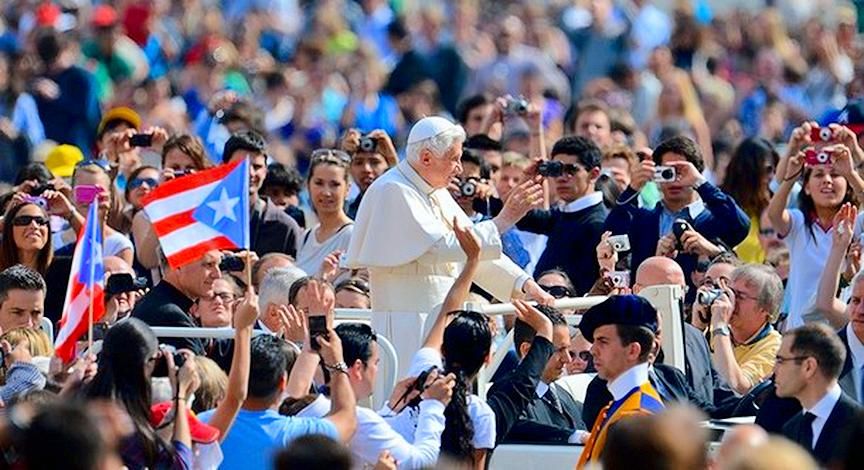
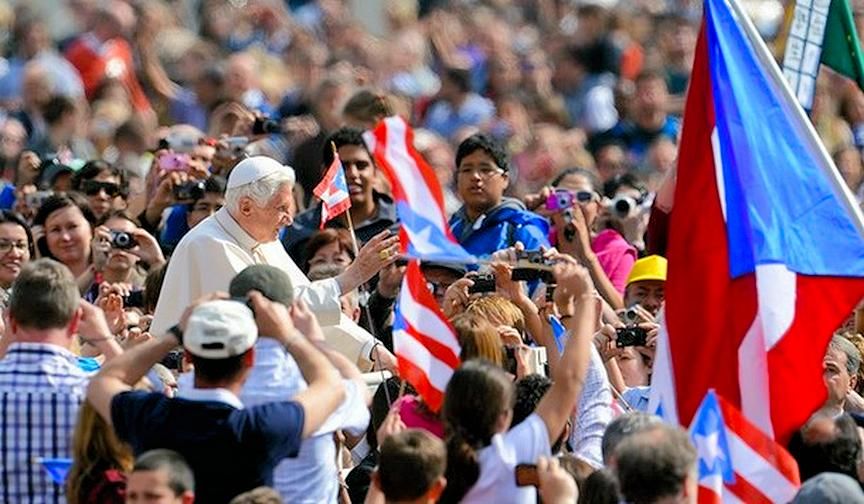
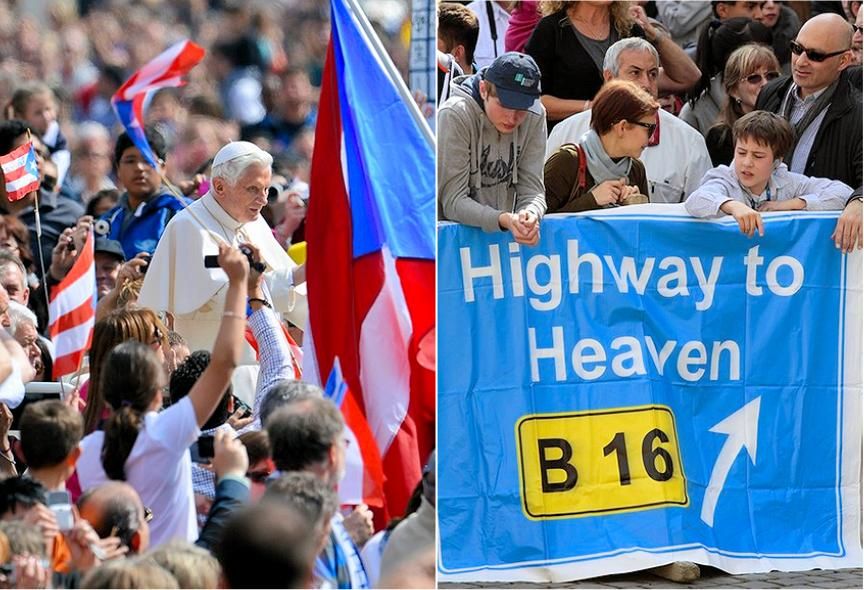
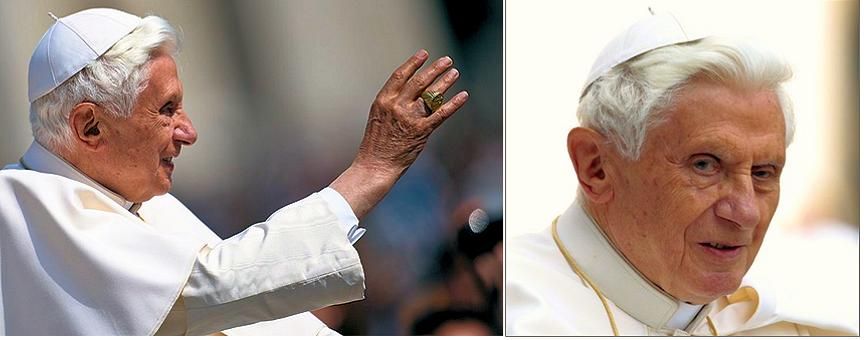 On the recent apostolic trip,
On the recent apostolic trip,
the Paschal Triduum, and
the menace of land mines

April 4, 2012
Some 20,000 pilgrims and tourists filled St. Peter's Square which has already being prepared for the Holy Week liturgies that will culminate in Pope Benedict’s Urbi et Orbi address and benediction to the city of Rome and the world this Easter Sunday.
The Holy Father dedicated most of his catechesis to his recent pilgrimage to Mexico and Cuba, describing the days spent there as “unforgettable” and “etched” in his heart.
But he also stressed that the principal aim of his visit to these nations – beyond press headlines – was to give courage and hope to the Church on the entire continent. And to affirm the need for progress in the recognition of fundamental human rights, including freedom of religion, because there is no progress in any society that "excludes God."
In English, he said:
My recent Apostolic Journey to Mexico and Cuba sought to confirm the people of those countries, and all the peoples of Latin America, in their faith and in the hope which makes it possible to build a just and harmonious social order.
At the liturgies in León, marked by an outpouring of devotion and spiritual joy, I encouraged the Mexican people to let their deep Christian roots inspire their efforts to overcome violence and to work for a better future.
In Cuba, I wished to reaffirm the Church in her public witness to the Gospel and to support the aspirations of all Cubans to a renewed, reconciled and free society. From Santiago de Cuba, I went as a pilgrim to the shrine of Our Lady of Charity of El Cobre and then to Havana, where I prayed for a rebirth of faith, openness to God’s love and respect for the truth about our human dignity and freedom revealed in Christ.
In these days, as we prepare to celebrate the saving events of Christ’s Passover from death to life in the sacred Triduum, may we open our hearts to God’s reconciling love revealed on the Cross. Let us allow that love to transform our lives, and enable us to celebrate with joy the mystery of the resurrection.
I offer a cordial welcome to all the English-speaking visitors present at today’s Audience, including the student groups from England, Ireland and the United States of America. I also greet the participants in the International Gathering of University Students. May your pilgrimage to Rome bear spiritual fruit in a deeper love of Christ and his Church. Upon you and your families I invoke the Lord’s blessings of wisdom, joy and peace. A happy and blessed Easter to all of you!
Tomorrow, the Paschal Triduum begins, when the Church commemorates the Passion and Death of Christ leading to Easter Sunday. Pope Benedict said: “The whole life of Jesus is oriented towards this hour, characterized by two aspects that illuminate each other: this is the hour of passage (metabasis) and the hour of love (agape) until the end."
“By participating in faith in the liturgical celebrations of the Paschal Triduum, we are invited to experience this transformation brought about by agape. Each one of us is loved by Jesus 'to the end', that is to the total gift of Himself on the cross when he cried: 'It is finished!' (Jn 19.30). Let us allow ourselves to be touched by this love, to be transformed, so that the resurrection may really be realized in us. I invite you, therefore, to live the Paschal Triduum intensely, and I wish you all a Holy Easter!”
On Holy Thursday, April 5, the Pope will concelebrate the Chrismal Mass in the Vatican basilica with the cardinals, bishops, and priests present in Rome.
Later in the day he will celebrate the Mass of the Lord’s Supper at the basilica of St. John Lateran.
On Good Friday, in the late afternoon, the Pope will preside at the reading of the Passion, adoration of the Cross, and Communion in the Vatican basilica. In the evening he will travel across town to the Roman Coliseum for the Stations of the Cross.
On Holy Saturday, the Pope will lead the Easter Vigil liturgy in the Vatican Basilica. On Easter Sunday morning, he will celebrate Mass in St. Peter’s Basilica and deliver his “Urbi et Orbi” message from the loggia of the basilica.
After the multilingual greetings, the Holy Father spoke in behalf of the UN-sponsored International Day for Mine Awareness and Assistance in Mine Action today:
Today marks the International Day to raise awareness about the problem of landmines – to the victims of which I express my closeness, as also to their families. I encourage everyone to be committed to freeing humanity from these terrible and devious weapons, which - as Blessed John Paul II said when the [International] Convention for their elimination went into force, keep people from, “walk[ing] together on paths of life without fearing the dangers of destruction and death. (Angelus of February 28th, 1999).
On December 8, 2005, the UN General Assembly declared that April 4 of each year would be observed as the International Day for Mine Awareness and Assistance in Mine Action.
It called for continued efforts by States, with the assistance of the United Nations and relevant organizations, to foster the establishment and development of national mine-action capacities in countries where mines and explosive remnants of war constitute a serious threat to the safety, health and lives of the civilian population, or an impediment to social and economic development at the national and local levels.
Long after wars are waged, mines remain a lurking threat to civilians in the peacetime that follows. Landmines are indiscriminate weapons that wait underground for years and sometimes decades, maiming and killing unsuspecting persons who happen to set them off. In 2010 there were 4,200 victims of landmines - 11 people a day.
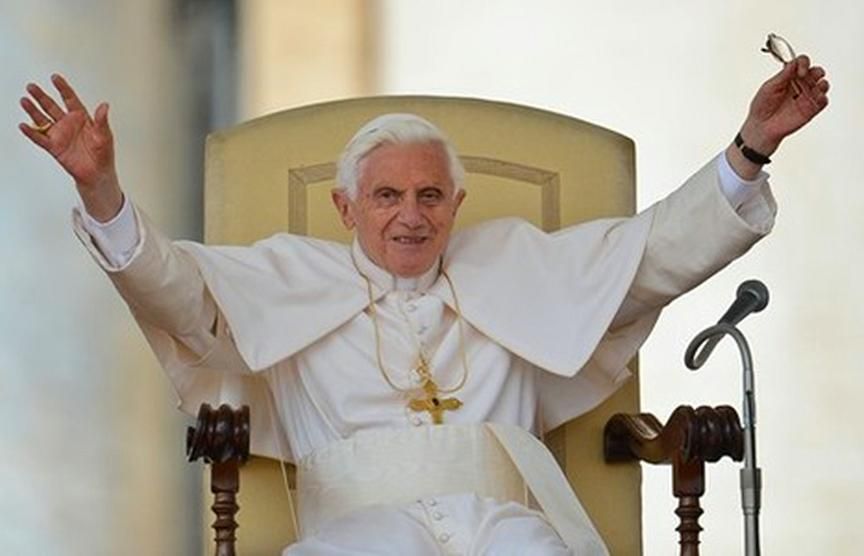

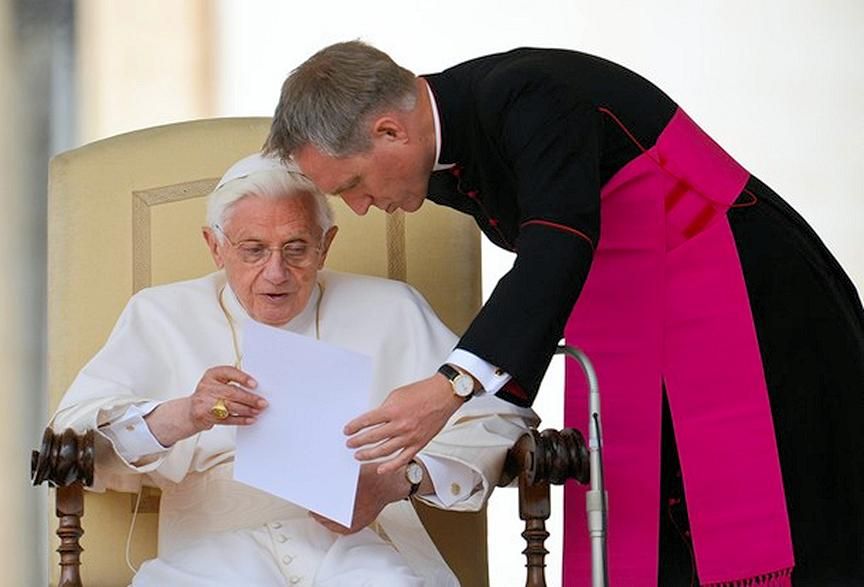
Dear brothers and sisters,
The emotions raised by my recent apostolic visit to Mexico and Cuba, on which I wish to dwell today, are still vivid in me. My spirit spontaneously gives thanks to the Lord, that in his providence, he willed that as the Successor of Peter I should visit these two countries who keep indelible memories of the visits made by Blessed John Paul II.
The bicentenary of the independence of Mexico and other Latin American countries, the twentieth anniversary of diplomatic relations between Mexico and the Holy See, and the fourth centenary of the discovery of the image of the Virgin of Charity of El Cobre in Cuba were the occasions for my pilgrimage.
With the trip, I wished to ideally embrace the entire Continent, asking all Latin Americans to live together in hope and in the concrete commitment to walk together united towards a better future.
I am grateful to the Presidents of Mexico and Cuba, as well as other authorities, who welcomed me with deference and courtesy.
I sincerely thank the Archbishops of Leon, of Santiago de Cuba and Havana and other venerated brothers in 6the episcopate who welcomed me with great affection. and their collaborators and all who generously gave of themselves for this pastoral visit of mine.
There were unforgettable days of joy and hope which will remain impressed in my heart.
The first stop was Leon, in the state of Guanajuato, the geographical center of Mexico. Here, a huge and festive crowd gave me an extraordinary and lively welcome as a sign of the warm embrace of an entire people.
From the arrival ceremony, I could grasp the faith and the warmth shown by the priests, consecrated persons and the lay faithful. In the presence of institutional representatives, many bishops and representatives of various social sectors, I recalled the need to acknowledge and safeguard the fundamental rights of the human being, the foremost being religious freedom and assured my closeness to those who suffer because of social scourges, old and new conflicts, corruption and violence.
With profound gratitude, I relive the thought of that interminable line of people along the streets who accompanied me with their enthusiasm. In those hands extended in greeting and affection, in those happy faces, in their cries of joy, I caught the tenacious hope of Mexican Christians, a hope that remained lit in their heats despite these difficult times of violence, which I could not fail to deplore, and to the victims of whom I hold deep-felt thoughts, and to a few of whom I was able to offer personal comfort.
On the same day, I met so many children and adolescents, who are the future of the nation and the Church. Their inexhaustible joy, expressed in resounding song and music, and their faces and their actions, expressed the strong desire of all the young people of Mexico, of Latin America and the Caribbean, to be able to live in peace, serenity and harmony, in a society that is more just and reconciled.
The disciples of the Lord should make the joy of Christians grow - the joy of belonging to his Church. This joy gives birth to the energies needed to serve Christ in situations of difficulty and suffering.
I recalled this truth to the immense crowd gathered for the Sunday Eucharistic celebration in Leon's Parco Bicentenario. I called on everyone to trust in the goodness of almighty God who can change unbearably dark situations from within, from the heart,
The Mexicans responded with their ardent faith, and in their believing adherence to the Gospel, I recognized once more comforting signs of hope for the Continent.
The last event of my visit to Mexico was the celebration of Vespers at the Cathedral of Our Lady of Light in Leon, with the Mexican bishops and representatives of the episcopates of America.
I manifested my closeness to their commitment in the face of various challenges and difficulties, and my gratitude wto those who sow the Gospel in complex situations which are often not devoid of limitations.
I encouraged them to be zealous pastors and sure-footed guides, inspiring everywhere sincere communion and sincere adherence to the teachings of the Church.
hus I left the beloved land of Mexico, where I experienced a special devotion and affection for the Vicar of Christ. Before leaving, I urged the Mexican people to remain faithful to the Lord and his Church, well-anchored in their own Christian roots.
The second part of my apostolic trip was in Cuba, where I went, above all, to sustain the mission of the Church in Cuba, which has been engaged in announcing the Gospel with joy, despite its poor means and the difficulties that still have to be overcome so that religion can carry out its spiritual and formative service in the public sphere of society.
I wished to underscore this upon arriving in Santiago de Cuba, the island's second most important city, while not failing to acknowledge the good relations between the Cuban State and the Holy See, aimed at establishing the living constructive presence of the Church in Cuba.
Among other things, I gave assurances that the Pope carries in his heart the concerns and aspirations of all Cubans, especially those who suffer from lack of freedom.
The first Holy Mass that I had the joy to celebrate on Cuban soil took place in the context of the fourth centenary of the finding of the image of the Virgin of Charity of El Cobre, patroness of Cuba.
It was an occasion of strong spiritual intensity, with the attentive and prayerful participation of tens of thousands of people, the sign of a Church that is emerging from situations that were not easy, but is doing so with visible testimonials of charity and of an active presence in the life of the people.
To Cuban Catholics, who, along with the entire population, hope for a better future, I addressed an invitation to give new vigor to their faith, and to contribute, with the courage of forgiveness and understanding, to the construction of an open and renewed society, where there will always be more space for God, because when God is set aside, the world becomes a place inhospitable to man.
Before leaving Santiago de Cuba, I went to the Shrine of Our Lady of Charity in El Cobre, so beloved to the Cuban people. The pilgrimage of the Virgin's image among the families of the whole island had aroused great spiritual enthusiasm, representing a significant event of new evangelization, and an occasion to rediscover the faith. To the Virgin Mary, I entrusted, most of all, everyone who suffers as well as the young Cubans.
The second Cuban stop was Havana, capital of the island. Young people, in particular, were the main protagonists of the exuberant welcome given to me during the ride from the airport to the Nunciature, where I had the opportunity to meet the bishops of the land in order to discuss the challenges that the Cuban Church is called on to face. knowing that the people have been looking to her with increasing trust.
The following day, I presided at Holy Mass in the main square of Havana which was filled with people. To all, I reminded that Cuba and the world need change, but that this can only happen if everyone opens up the the integral truth about man, the indispensable prerequisite for achieving freedom, and decides to sow reconciliation and brotherhood around himself, basing his own life on Jesus Christ.
Only he can dispel the darkness of error, helping us to defeat evil and everything that oppresses us. I wished, among other things, to reiterate that the Church does not seek privileges, but only to be able to proclaim and celebrate the faith publicly, carrying the Gospel message of peace and hope into every part of society.
Appreciating the steps that have been taken so far in this sense by Cuban authorities, I underscored that it is necessary to continue along this path of ever greater religious freedom.
When I left Cuba, tens of thousands of Cubans came to send me off, lining the streets to the airport despite heavy rain. In the departure ceremony, I recalled that today, the various components of Cuban society are called on to an effort of sincere collaboration and patient dialog for the good of the nation.
In this perspective, I wanted my presence on the island as a witness for Jesus Christ to be an encouragement for Cubans to open the doors of their heart to him who is the source of hope and strength that can make goodness grow.
And so I bade farewell to the Cubans, exhorting them to revive the faith of their fathers and build an ever better future.
This trip to Mexico and Cuba, thank God, had the desired pastoral outcome. May the Mexican and Cuban peoples derive abundant fruits from it to construct a future of peace and fraternity in ecclesial communion and with evangelical courage.
Dear friends, tomorrow afternoon, with the Holy Mass of the Lord's Supper, we enter the Paschal Triduum, the peak of the liturgical year, in order to celebrate the central mystery of the faith: the passion, death and resurrection of Christ.
In the Gospel of St. John, this culminating moment of the mission of Jesus is called his 'hour', which opens with the Last Supper. The Gospel introduces it thus: "Before the feast of Passover, Jesus knew that his hour had come to pass from this world to the Father. He loved his own in the world and he loved them to the end" (Jn 13,1).
All of Christ's life was oriented to this hour, characterized by two aspects which illuminate each other: it is the hour of 'passage' (metabasis) and the hour of 'love (agape) to the very end".
In effect, it is truly divine love, the Spirit with which Jesus was filled, that allowed Jesus to 'pass' through the abyss of evil and death to emerge into the new 'space' of the resurrection.
It is agape, love, that works this transformation. enabling Jesus to go beyond the limits of the human condition marked by sin, and to overcome the barrier that keeps man prisoner, separated from God and eternal life.
Participating with faith in the liturgical celebrations of the Paschal Triduum, we are invited to live this transformation enabled by agape. Each of us is loved Jesus 'to the very end', up to his total self-giving on the Cross, when he cried out: "It is finished!" (Jn 19,30).
Let us allow this love to reach us, let us allow ourselves to be transformed in order that the resurrection can truly be realized in ourselves. I therefore call on you to live the Paschal Triduum with intensity, and I wish everyone a Holy Easter. Thank you.
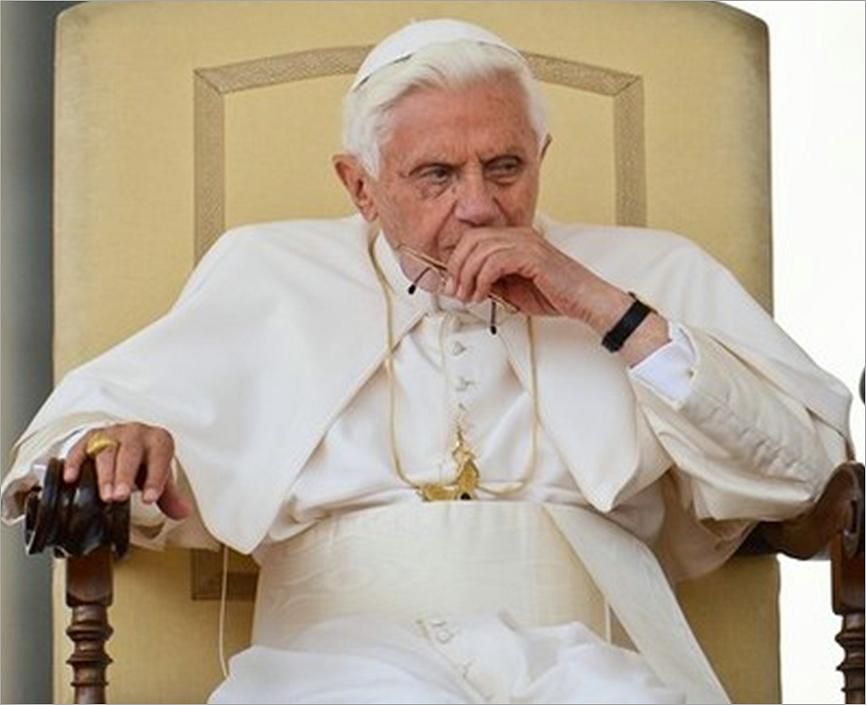
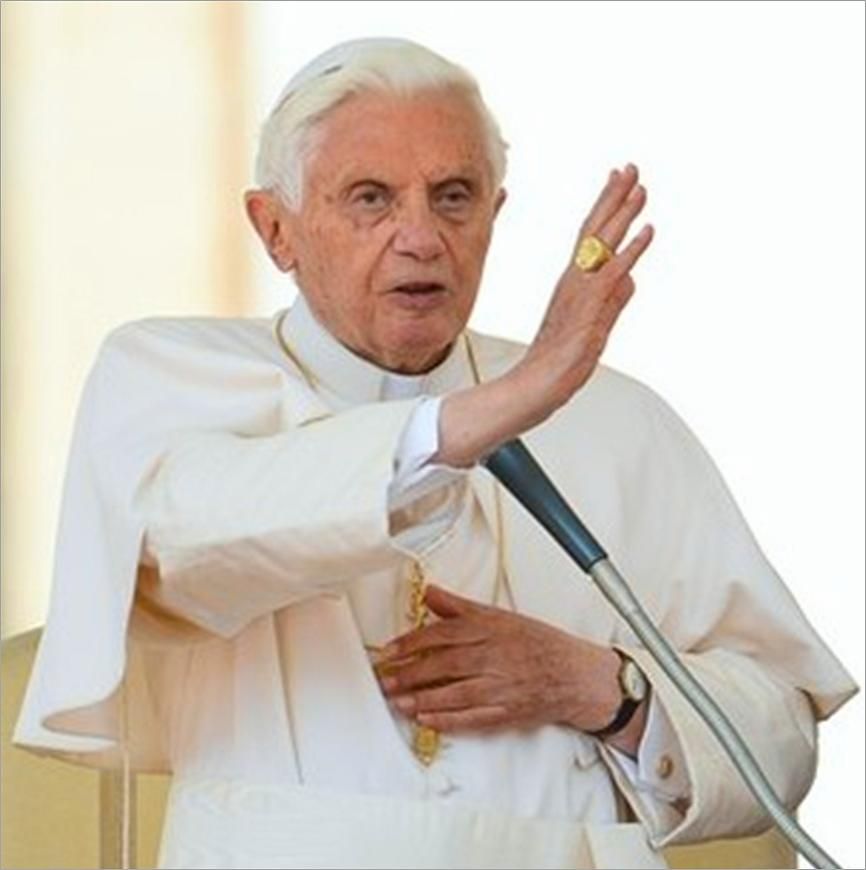

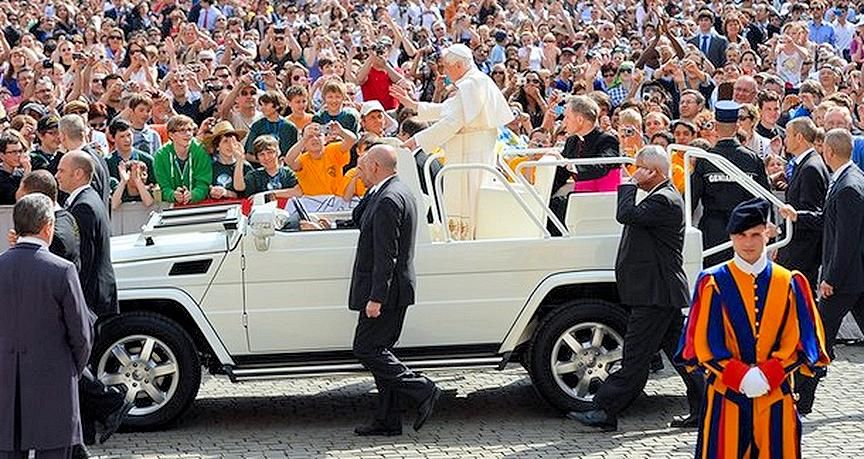 Giant Easter egg for the Pope
Giant Easter egg for the Pope
will go to a juvenile detention center
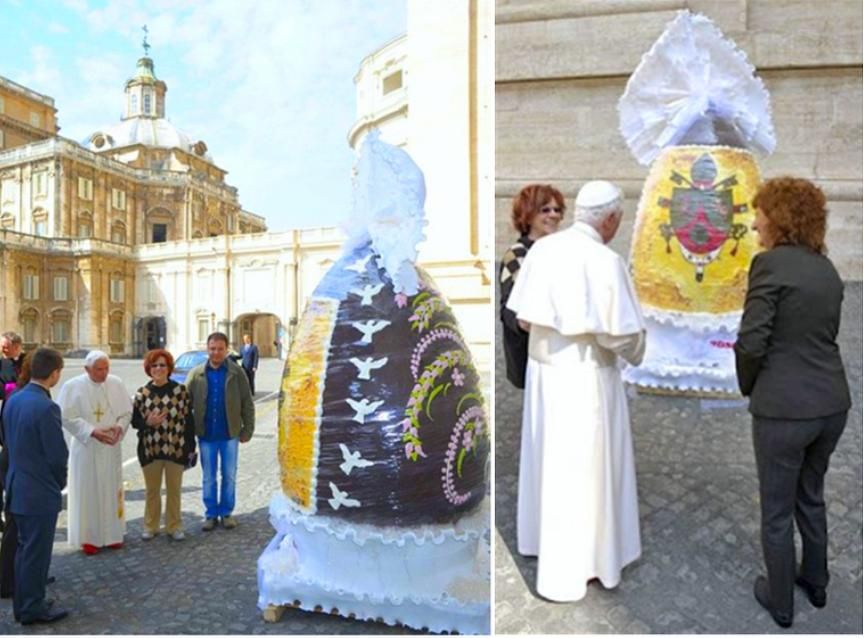
After the General Audience, the Holy Father was presented with a giant chocolate Easter egg 2.2 meters tall and weighing 250 kilograms by the owners of a thriving business in home-style bakery products, Tosca di Casalbuttano in Cremona, northern Italy.
The Vatican announced that the Pope is donating the egg to the juvenile detention center of Casal del Marmo in Rome (visited by the Pope in 2008). [If there are 250 detainees, it means each of them gets a kilogram of chocolate!]
In 1996, the same company gave John Paul II a similar Easter egg.
[Modificato da TERESA BENEDETTA 06/04/2012 16:32] |
| |
 04/04/2012 23:43 04/04/2012 23:43 |
|
| | | OFFLINE | Post: 405
Post: 115 | Registrato il: 28/05/2007
Registrato il: 19/02/2009 | Utente Comunità | Utente Junior | |
|
Just as an additional info regarding the 'B16-Highway to Heaven' pic.
B in Germany is short for Bundesstraße -> Federal Road.
Now guess which quaint, little suburb of Regensburg B 16 leads to!?
Too sweet!! ![[SM=g7566]](https://im0.freeforumzone.it/up/0/66/3457662.gif)
 And that is truly serendipitous, thanks for the information!
And that is truly serendipitous, thanks for the information!
Even in the tiny details, God provides....!
TERESA
[Modificato da TERESA BENEDETTA 05/04/2012 05:21] |
| |
 05/04/2012 16:18 05/04/2012 16:18 |
|
| | | OFFLINE | | Post: 24.603
Post: 7.137 | Registrato il: 28/08/2005
Registrato il: 20/01/2009 | Administratore | Utente Master | |
|
|
| |
 05/04/2012 18:30 05/04/2012 18:30 |
|
| | | OFFLINE | | Post: 24.604
Post: 7.138 | Registrato il: 28/08/2005
Registrato il: 20/01/2009 | Administratore | Utente Master | |
|

 Maundy Thursday
Maundy Thursday
MASS OF THE CHRISM
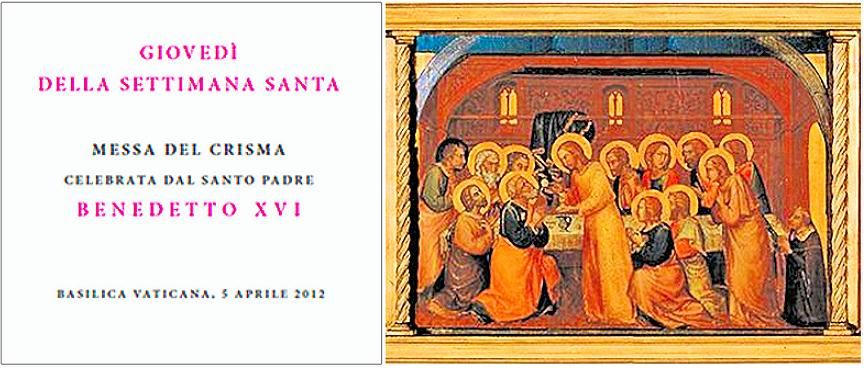 Libretto cover: Last Supper, from a polyptych by Matteo da Giovanni, 1340, Stanze di Raffaele, Vatican Apostolic Palace.
Pope reminds priests:
Libretto cover: Last Supper, from a polyptych by Matteo da Giovanni, 1340, Stanze di Raffaele, Vatican Apostolic Palace.
Pope reminds priests:
'Disobedience is not
a path to renewal'

April 5, 2012
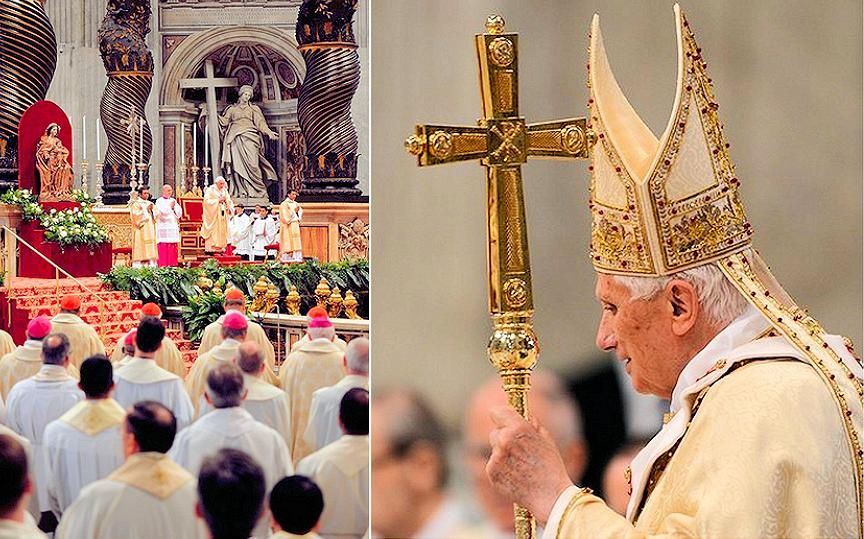
Pope Benedict on Thursday morning presided at the Chrism Mass in St Peter’s Basilica, addressing his homily especially to priests on the day the Church commemorates Christ’s institution of the priesthood.
Some 1600 priests from the Rome diocese were present in the Basilica to hear the Pope’s words and to renew their vows during this Holy Thursday liturgy.
Speaking about the situation of the church today, Pope Benedict responded directly to a call to disobedience made recently by a group of priests in Austria that is calling for changes to the teaching on women priests and other traditional aspects of the Magisterium.
Recalling the words of his predecessor, John Paul II who said the Church has no authority from the Lord to ordain women priests, Benedict asked ‘Is disobedience a path of renewal for the Church?’
Pope Benedict said anyone who considers the history of the post-conciliar era can recognise the process of true renewal which, he added, often took – and continues to take - unexpected forms.
"If we look at the people from whom these fresh currents of life burst forth, he said, we see this requires being filled with the joy of faith, the radicalism of obedience, the dynamism of hope and the power of love."
Pope Benedict stressed that configuration to Christ is the precondition and basis for all renewal in the Church and he reminded priests they are charged with teaching the faith to a society that is growing increasingly illiterate in matters of the basic foundations of faith.
While they must be concerned with the whole human person and therefore the physical needs of the sick, the hungry, the homeless, he said priests should also be filled with enthusiasm as they respond also to the needs of the soul.
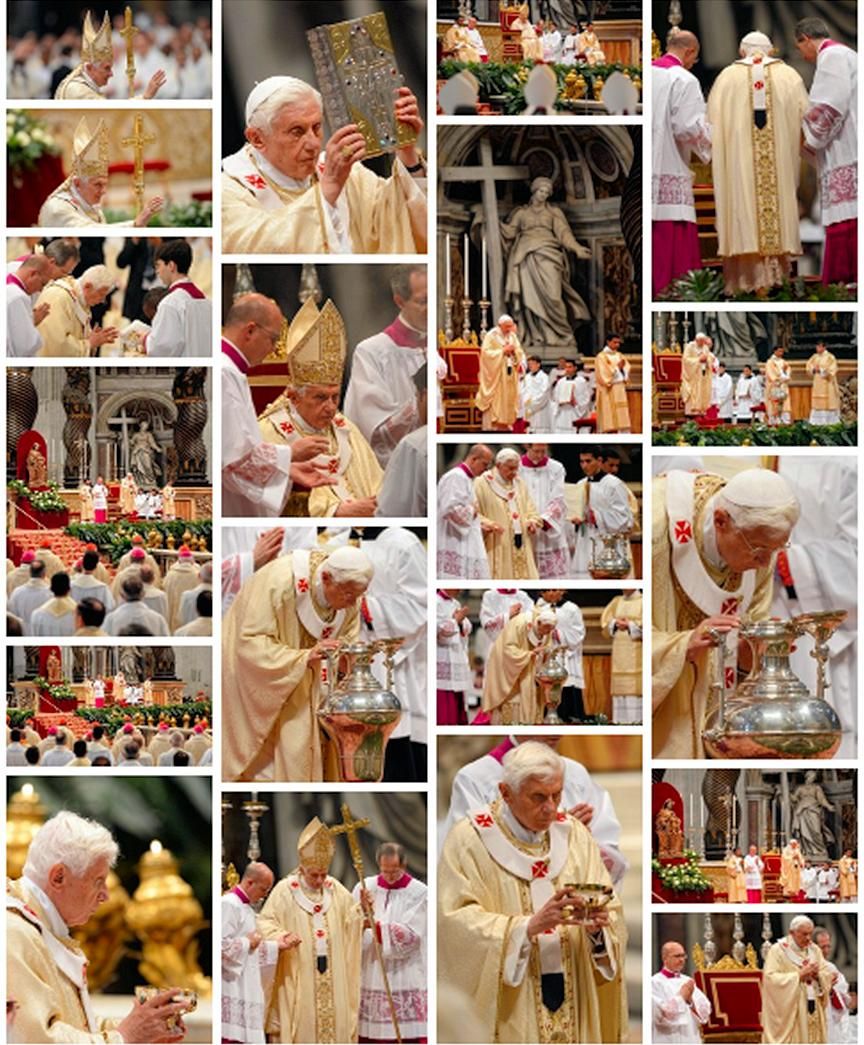
Here is the official Vatican translation of the Holy Father's homily:
Dear Brothers and Sisters,
At this Holy Mass our thoughts go back to that moment when, through prayer and the laying on of hands, the bishop made us sharers in the priesthood of Jesus Christ, so that we might be “consecrated in truth” (Jn 17:19), as Jesus besought the Father for us in his high-priestly prayer.
He himself is the truth. He has consecrated us, that is to say, handed us over to God for ever, so that we can offer men and women a service that comes from God and leads to him.
But does our consecration extend to the daily reality of our lives – do we operate as men of God in fellowship with Jesus Christ? This question places the Lord before us and us before him.
“Are you resolved to be more united with the Lord Jesus and more closely conformed to him, denying yourselves and confirming those promises about sacred duties towards Christ’s Church which, prompted by love of him, you willingly and joyfully pledged on the day of your priestly ordination?”
After this homily, I shall be addressing that question to each of you here and to myself as well. Two things, above all, are asked of us: there is a need for an interior bond, a configuration to Christ, and at the same time there has to be a transcending of ourselves, a renunciation of what is simply our own, of the much-vaunted self-fulfilment.
We need, I need, not to claim my life as my own, but to place it at the disposal of another – of Christ. I should be asking not what I stand to gain, but what I can give for him and so for others.
Or to put it more specifically, this configuration to Christ, who came not to be served but to serve, who does not take, but rather gives – what form does it take in the often dramatic situation of the Church today?
Recently a group of priests from a European country issued a summons to disobedience, and at the same time gave concrete examples of the forms this disobedience might take, even to the point of disregarding definitive decisions of the Church’s Magisterium, such as the question of women’s ordination, for which Blessed Pope John Paul II stated irrevocably that the Church has received no authority from the Lord.
Is disobedience a path of renewal for the Church? We would like to believe that the authors of this summons are motivated by concern for the Church, that they are convinced that the slow pace of institutions has to be overcome by drastic measures, in order to open up new paths and to bring the Church up to date.
But is disobedience really a way to do this? Do we sense here anything of that configuration to Christ which is the precondition for true renewal, or do we merely sense a desperate push to do something to change the Church in accordance with one’s own preferences and ideas?
But let us not oversimplify matters. Surely Christ himself corrected human traditions which threatened to stifle the word and the will of God? Indeed he did, so as to rekindle obedience to the true will of God, to his ever enduring word.
His concern was for true obedience, as opposed to human caprice. Nor must we forget: he was the Son, possessed of singular authority and responsibility to reveal the authentic will of God, so as to open up the path for God’s word to the world of the nations.
And finally: he lived out his task with obedience and humility all the way to the Cross, and so gave credibility to his mission. Not my will, but thine be done: these words reveal to us the Son, in his humility and his divinity, and they show us the true path.
Let us ask again: do not such reflections serve simply to defend inertia, the fossilization of traditions? No.
Anyone who considers the history of the post-conciliar era can recognize the process of true renewal, which often took unexpected forms in living movements and made almost tangible the inexhaustible vitality of holy Church, the presence and effectiveness of the Holy Spirit.
And if we look at the people from whom these fresh currents of life burst forth and continue to burst forth, then we see that this new fruitfulness requires being filled with the joy of faith, the radicalism of obedience, the dynamic of hope and the power of love.
Dear friends, it is clear that configuration to Christ is the precondition and the basis for all renewal. But perhaps at times the figure of Jesus Christ seems too lofty and too great for us to dare to measure ourselves by him.
The Lord knows this. So he has provided “translations” on a scale that is more accessible and closer to us. For this same reason, Saint Paul did not hesitate to say to his communities: Be imitators of me, as I am of Christ. For his disciples, he was a “translation” of Christ’s manner of life that they could see and identify with.
Ever since Paul’s time, history has furnished a constant flow of other such “translations” of Jesus’s way into historical figures. We priests can call to mind a great throng of holy priests who have gone before us and shown us the way: from Polycarp of Smyrna and Ignatius of Antioch, from the great pastors Ambrose, Augustine and Gregory the Great, through to Ignatius of Loyola, Charles Borromeo, John Mary Vianney and the priest-martyrs of the 20th century, and finally Pope John Paul II, who gave us an example, through his activity and his suffering, of configuration to Christ as “gift and mystery”.
The saints show us how renewal works and how we can place ourselves at its service. And they help us realize that God is not concerned so much with great numbers and with outward successes, but achieves his victories under the humble sign of the mustard seed.
Dear friends, I would like briefly to touch on two more key phrases from the renewal of ordination promises, which should cause us to reflect at this time in the Church’s life and in our own lives.
Firstly, the reminder that – as Saint Paul put it – we are “stewards of the mysteries of God” (1 Cor 4:1) and we are charged with the ministry of teaching (munus docendi), which forms a part of this stewardship of God’s mysteries, through which he shows us his face and his heart, in order to give us himself.
At the meeting of Cardinals on the occasion of the recent Consistory, several of the pastors of the Church spoke, from experience, of the growing religious illiteracy found in the midst of our sophisticated society.
The foundations of faith, which at one time every child knew, are now known less and less. But if we are to live and love our faith, if we are to love God and to hear him aright, we need to know what God has said to us – our minds and hearts must be touched by his word.
The Year of Faith, commemorating the opening of the Second Vatican Council fifty years ago, should provide us with an occasion to proclaim the message of faith with new enthusiasm and new joy.
We find it of course first and foremost in sacred Scripture, which we can never read and ponder enough. Yet at the same time we all experience the need for help in accurately expounding it in the present day, if it is truly to touch our hearts.
This help we find first of all in the words of the teaching Church: the texts of the Second Vatican Council and the Catechism of the Catholic Church are essential tools which serve as an authentic guide to what the Church believes on the basis of God’s word.
And of course this also includes the whole wealth of documents given to us by Pope John Paul II, still far from being fully explored.
All our preaching must measure itself against the saying of Jesus Christ: “My teaching is not mine” (Jn 7:16). We preach not private theories and opinions, but the faith of the Church, whose servants we are.
Naturally this should not be taken to mean that I am not completely supportive of this teaching, or solidly anchored in it. In this regard I am always reminded of the words of Saint Augustine: what is so much mine as myself? And what is so little mine as myself? I do not own myself, and I become myself by the very fact that I transcend myself, and thereby become a part of Christ, a part of his body the Church.
If we do not preach ourselves, and if we are inwardly so completely one with him who called us to be his ambassadors, that we are shaped by faith and live it, then our preaching will be credible. I do not seek to win people for myself, but I give myself.
The Curé of Ars was no scholar, no intellectual, we know that. But his preaching touched people’s hearts because his own heart had been touched.
The last keyword that I should like to consider is “zeal for souls”: animarum zelus. It is an old-fashioned expression, not much used these days. In some circles, the word “soul” is virtually banned because – ostensibly – it expresses a body-soul dualism that wrongly compartmentalizes the human being.
Of course the human person is a unity, destined for eternity as body and soul. And yet that cannot mean that we no longer have a soul, a constituent principle guaranteeing our unity in this life and beyond earthly death.
And as priests, of course, we are concerned for the whole person, including his or her physical needs – we care for the hungry, the sick, the homeless. And yet we are concerned not only with the body, but also with the needs of the soul: with those who suffer from the violation of their rights or from destroyed love, with those unable to perceive the truth, those who suffer for lack of truth and love.
We are concerned with the salvation of men and women in body and soul. And as priests of Jesus Christ we carry out our task with enthusiasm. No one should ever have the impression that we work conscientiously when on duty, but before and after hours we belong only to ourselves.
A priest never belongs to himself. People must sense our zeal, through which we bear credible witness to the Gospel of Jesus Christ. Let us ask the Lord to fill us with joy in his message, so that we may serve his truth and his love with joyful zeal. Amen.
[Modificato da TERESA BENEDETTA 05/04/2012 22:03] |
| |
 05/04/2012 18:57 05/04/2012 18:57 |
|
| | | OFFLINE | | Post: 24.605
Post: 7.139 | Registrato il: 28/08/2005
Registrato il: 20/01/2009 | Administratore | Utente Master | |
|
 Pope uses Holy Thursday homily
Pope uses Holy Thursday homily
to chastise dissident priests
By Nicole Winfield

vatican city , April 5 (AP) - Pope Benedict XVI denounced priests who have questioned Church teaching on celibacy and ordaining women, saying Thursday they were disobeying his authority to try to impose their own ideas on the church.
[Winfield's statement 'disobeying his authority' is blatant misrepresentation of what the Pope clearly said, namely "disregarding definitive decisions of the Church’s Magisterium". Nothing in the Pope's statements imply - or would ever imply - in any way that he is accusing the dissidents of disobeying his authority - since the authority is not his, as by personal title, but that of the Church.]
Benedict made the rare and explicit criticism from the altar of St. Peter's Basilica in his homily on Holy Thursday, when priests recall the promises they made when ordained.
In 2006, a group of Austrian priests launched the Pfarrer Initiative, a call to disobedience aimed at abolishing priestly celibacy and opening up the clergy to women to relieve the shortages of priests.
Last June, the group essentially threatened a schism, saying the Vatican's refusal to hear their complaints left them no choice but to "follow our conscience and act independently."
They issued a revised call to disobedience in which they said parishes would celebrate Eucharistic services without priests, that they would let women preach, and they pledged to speak out publicly and frequently for a female and a married priesthood.
The group now reportedly numbers more than 300 Austrian priests and deacons as well as supporters in other countries, and its influence has grown to such an extent that top Austrian bishops met with Vatican officials in January to discuss how to handle them, Italian news reports said.
So far, neither the Vatican nor the archbishop of Vienna, Cardinal Christoph Schoenborn, have imposed any canonical penalties on them.
In his homily, Benedict said the dissidents claim to be motivated by concern for the Church. But he suggested that in reality they were just making "a desperate push to do something to change the Church in accordance with (their) own preferences and ideas."
"We would like to believe that the authors of this summons are motivated by concern for the Church, that they are convinced that the slow pace of institutions has to be overcome by drastic measures, in order to open up new paths and to bring the Church up to date," he said. "But is disobedience really a way to do this?"
He said Jesus always followed true obedience to God's will, not "human caprice."
The head of the initiative, Rev. Hellmut Schueller, downplayed the severity of Benedict's message and said the Pope was merely asking for reflection on whether disobedience can reform the church.
In a telephone interview with The Associated Press, Schueller noted that Benedict didn't forbid what the dissident priests were doing or advocating. {Oh, please! What was the Pope supposed to do? Issue explicit prohibitions from the pulpit on Maundy Thursday? None are so deaf as those who will not listen to anything but their own will!]
"We are listening with interest to this message," he said. "I cannot see it as a very sharp wording."
The members of the initiative, he said, will reflect on Benedict's words as part of a dialogue he said he hopes to open with Austrian bishops.
"We have decided to go this way because it's the way of our conscience, as faithful, and we are expressing only the opinion of the people at the base of the church."
He said the initiative did not seek to split the Church or create schism, saying the positions articulated in the call for disobedience increasingly reflected the will of ordinary Catholics.
Any divisions that are being created, he said, are between the base of the church and the hierarchy.
[Once again, of course, the AP is, in effect, giving a moral equivalence to what the Pope says in a homily to a dissident's partisan view, in which the basic flaw is to think that the Church is a democracy whose Tradition and practices can be altered at will by its 'base'! What faith deserves to be called a faith that would allow its precepts to be altered at will? That is one of the main reasons the Church of England is now foundering.]
Holy Thursday homilies are often a bit unusual in that the Pope uses them to issue direct messages to priests. In 2006, Benedict read a letter written by a cleric who was killed as he prayed in Turkey.
And on Holy Thursday in 2002, Pope John Paul II broke his silence over the explosion of the U.S. sex abuse scandal, denouncing the sins of priestly abusers and the "grave scandal" that was casting a "dark shadow of suspicion" over all priests.
Very predictably, the MSM dribbles the ball - a first sampling:
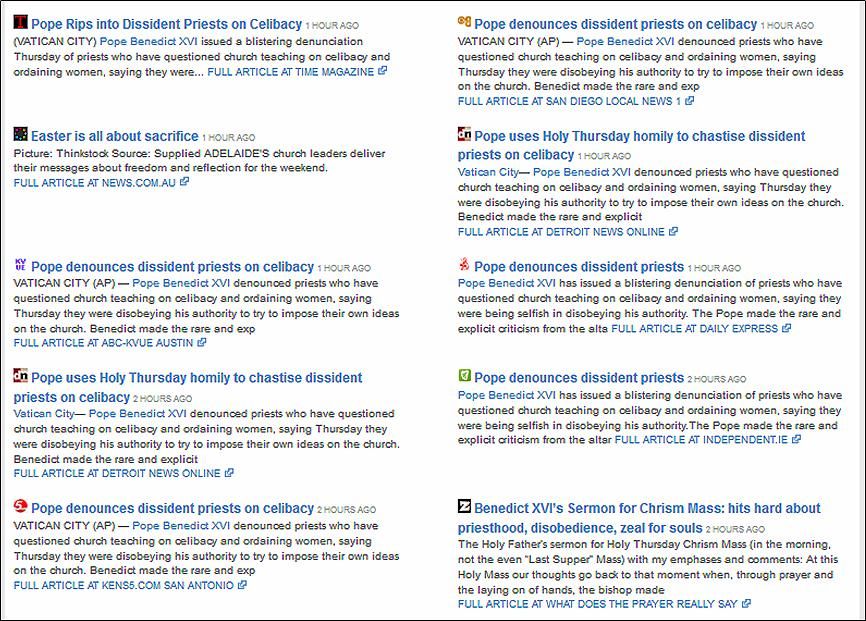 Pope assails ‘disobedience’
Pope assails ‘disobedience’
among priests
By RACHEL DONADIO

April 5, 2012
ROME — Striking the tone that once earned him the moniker “God’s Rottweiler,” Pope Benedict XVI in a stern Holy Thursday homily denounced “disobedience” in the Church, chastising reform-minded priests who seek the ordination of women and the abolition of priestly celibacy. [The writer gives the impression that the Pope barked out his reprimand, or that this was the first time he has ever been stern towards priests and bishops!]
Referring to recent initiatives by clerics in Austria and elsewhere, Benedict said that while such priests claim to act “for concern for the church,” they are driven by their “own preferences and ideas,” and should instead turn toward a “radicalism of obedience” — a phrase that perfectly captures the essence of the theologian Pope’s thought. [I am actually surprised Donadio grants this, even though the idea of the 'radicalism of obedience' would strike anyone who considers Benedict's use of words.]
While there was nothing new in the contents of Benedict’s message, it was one of the strongest — and most direct — speeches of a seven-year-old reign that has more often been dominated by a sexual abuse scandal, repeated tangles with other faiths and a Vatican hierarchy in disarray.
[And that is how, unfortunately, MSM will seek to characterize (and therefore diminish) the seven exalting and inspiring years of a Pontificate whose radical actions to restore the faith would appear to be completely ignored by the MSM, who prefer to see only everything negative that they themselves mostly generated.
1) The sexual abuse scandal has not dominated this Pontificate - it's the media that has made the issue 'dominate'. To begin with, most of the 'scandal' occurred before Benedict XVI became Pope.
2) What 'repeated tangles with other faiths'? The Regensburg lecture opened up a dialog with thinking Muslims for the first time in history. Outstanding issues with the Jews are fairly minor, chronic and political - the Good Friday prayer and their hostility to Pius XII. There was no 'tangle' with Anglicanism. It was the disaffected Anglicans who more than a decade ago, started asking Rome for a mechanism to convert en masse. And what could the Church of England do to stop those who wished to convert and did? And
3) What, pray, is in disarray with the Vatican hierarchy, except some unfortunate mismanagement at the Secretariat of State? Everything else is in place, and the present Roman Curia cannot possibly be faulted more than any preceding Curia in the modern age. And yet, notice how a malicious (or at the very least, hopelessly biased) writer can manage to diminish if not dismiss a Pontificate in a few choice phrases!]
It also showed Benedict, who at almost 85 has been showing his age, in fighting form as a defender of orthodoxy, favoring a smaller church of more ardent believers over a larger community that relies on diluted doctrine. [Thank you for seeing that!]
The Pope delivered his homily from a golden throne in Saint Peter’s Basilica on Holy Thursday, the day priests recall the vows they made when ordained.
He was clearly referring to an Austrian group called Preachers’ Initiative [Pfarrer in Pfarrer-Initiative means 'parish priest' not preacher], which has issued a “Call to Disobedience,” asking the Church to allow the ordination of women, to remove the obligation of priestly celibacy and to permit priests to allow divorced people to receive Communion.
The initiative was started in 2006 by Father Helmut Schüller, a former director of the Catholic aid agency Caritas in Austria, to combat a shortage of priests. Since then, more than 400 Austrian priests have endorsed him, according to media reports, including priests in the United States and across Europe. [Considering that there are 400,000 priests worldwide, 400 is truly an impressive figure, right?]
The Vatican fears that the initiative could cause a schism in the Church. For his part, Father Schüller has called the Vatican an “absolutist monarchy” and said that the Church’s resistance to change might lead to rupture anyway.
In a telephone interview on Thursday, Father Schüller said he was surprised by Benedict’s words. “But I don’t think they were very harsh. There was no threat or sanction implied,” he said.
“I think that in the history of the Church, a lot has changed, even if not always voluntarily,” Father Schüller said. “There has been new science, new technology, new practices. The teachings are always changing.” [REALLY! Name one!]
Allowing women or married men to enter the priesthood “is not a question of faith, but one of tradition,” Father Schüller added. “It is not a matter of theology, but of history and tradition. And those are constantly evolving.”
In his homily, Benedict made clear that reforms cannot go against Church doctrine. He singled out “a group of priests from a European country” who had recently “issued a summons to disobedience.”
They had done this to the point of disregarding church teaching and encouraging “women’s ordination, for which Blessed Pope John Paul II stated irrevocably that the Church has received no authority from the Lord,” Benedict said.
In 1994, John Paul issued an apostolic letter saying that that the Church “has no authority whatsoever” to ordain women, citing among its reasons that the apostles of Jesus Christ were all men.
“We would like to believe that the authors of this summons are motivated by concern for the Church, that they are convinced that the slow pace of institutions has to be overcome by drastic measures, in order to open up new paths and to bring the Church up to date. But is disobedience really a way to do this?” Benedict continued.
Striking a characteristically inquisitive [The adjective is obviously inappropriate -'rhetorical' is probably the best word for what the writer means - but the writer chose it nonetheless because it recalls the Inquisition and other dark associations that the MSM have built around the figure of Joseph Ratzinger], if yet uncompromising stance, he asked whether such moves were aimed at “true renewal,” or “do we merely sense a desperate push to do something to change the Church in accordance with one’s own preferences and ideas?”
Instead, the Pope said, Christ’s concern “was for true obedience, as opposed to human caprice.”
Benedict said that priests should look to renewal in a “radicalism of obedience,” and turn to the saints, not modern convention, for guidance.
Vatican watchers said that the Pope’s remarks pointed to a growing battle in the Catholic world. “In spite of the ‘tough’ response of the Pope, I think that the calls for reform won’t diminish, they will only grow,” said Paolo Rodari, a Vatican expert at the Italian daily Il Foglio. “It’s a problem that the Vatican will increasingly have to come to terms with.”
[Rodari notoriously takes a very a-historical, short-term view of the beat he covers. When did the Church ever not have calls for reform to one degree or other? This Austrian initiative is the latest version of the 'We are Church' manifesto and many similar dissident manifestos that have sprung up since Vatican II. None of these dissident groups have ever had the courage to leave the Church for the most obvious reasons - they will cease to have much news value once they step out, and it's not all that easy to set up a new 'church'. It's so much easier to stay within the Church and become media favorites for dissenting against a Church that MSM in general are rooting to fail, and exultantly ride a monumental ego trip with the delusion that they can change this 2000-year-old Church by thesmelves.
What a paradox that the Lefebvrians stand apart from the Church because they oppose some precepts of Vatican II, whereas the liberal dissenters set themselves apart because of a mistaken [deliberate, I think] understanding of Vatican II.]
[Modificato da TERESA BENEDETTA 05/04/2012 20:37] |
| |
 05/04/2012 21:57 05/04/2012 21:57 |
|
| | | OFFLINE | | Post: 24.606
Post: 7.140 | Registrato il: 28/08/2005
Registrato il: 20/01/2009 | Administratore | Utente Master | |
|

 Maundy Thursday
Maundy Thursday
MASS OF THE LORD'S SUPPER
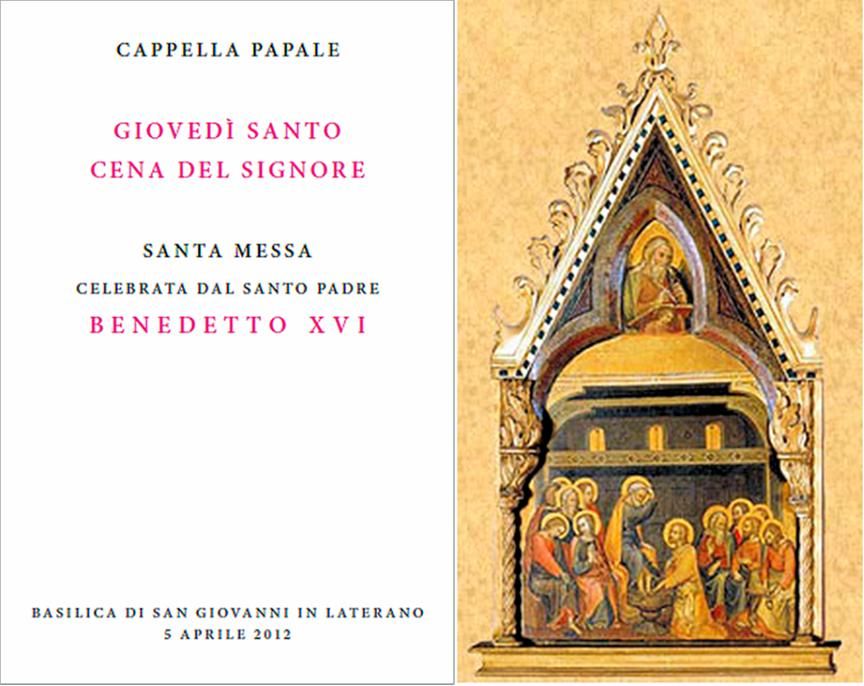 Libretto cover: Detail from a polyptych by Matteo di Giovanni, 1340, Sala di Sant'Ambrogio, Vatican Apostolic Palace.
The Pope's reflection:
Libretto cover: Detail from a polyptych by Matteo di Giovanni, 1340, Sala di Sant'Ambrogio, Vatican Apostolic Palace.
The Pope's reflection:
Jesus on Gethsemane shows
false opposition between
obedience and freedom

April 5, 2012
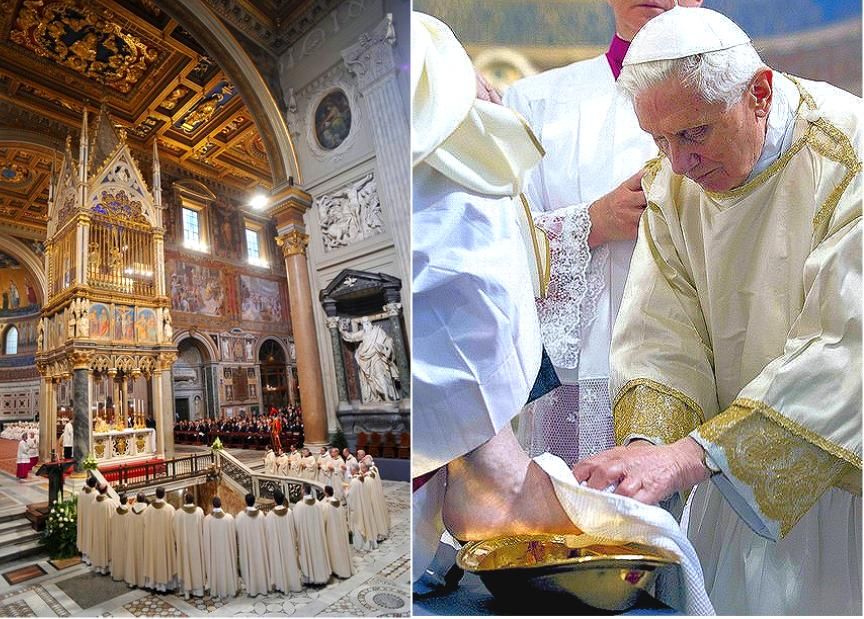
In the dark night of the Mount of Olives, “Jesus resolved the false opposition between obedience and freedom and opened the path to freedom”, said Pope Benedict XVI this Holy Thursday, during the Mass of Our Lord’s Supper at the Basilica of St. John lateran.
“We think we are free and truly ourselves only if we follow our own will. God appears as the opposite of our freedom”. This he said, is “the fundamental lie which perverts life”.
As the sun set over the Tiber, Pope Benedict XVI crossed Rome to the Lateran Basilica, his seat as Bishop of Rome to markd the end of Lent and the beginning of the sacred "Triduum" (three days) of Holy Week: From sundown Holy Thursday to Vespers on Easter Sunday, commemorating Christ’s Passion, death and Resurrection.
The Mass of Our Lord’s Last Supper is celebrated in the evening, because Passover, the Jewish feast Jesus and his disciples celebrated before his Passion, begins at sundown. The Mass commemorates Our Lord's institution of the Holy Eucharist at the Last Supper in the Upper Room.
But as Pope Benedict pointed out in his homily: “Holy Thursday also belongs to the dark night of the Mount of Olives”.
It is into this dark night that Jesus goes, in prayer to encounter the darkness of death. “Night”, said the Pope, “signifies lack of communication, a situation where people do not see each other... a symbol of incomprehension, of an obscuring of the truth”, where evil has room to grow. A night that Jesus enters to overcome it.
Pope Benedict then turned to the prayer of Jesus on the Mount of Olives, saying that from it we can learn trust in God who is goodness and power.
“Christians, in kneeling, enter into Jesus’s prayer... When menaced by the power of evil, as they kneel, they are upright before the world, while as sons and daughters, they kneel before the Father”.
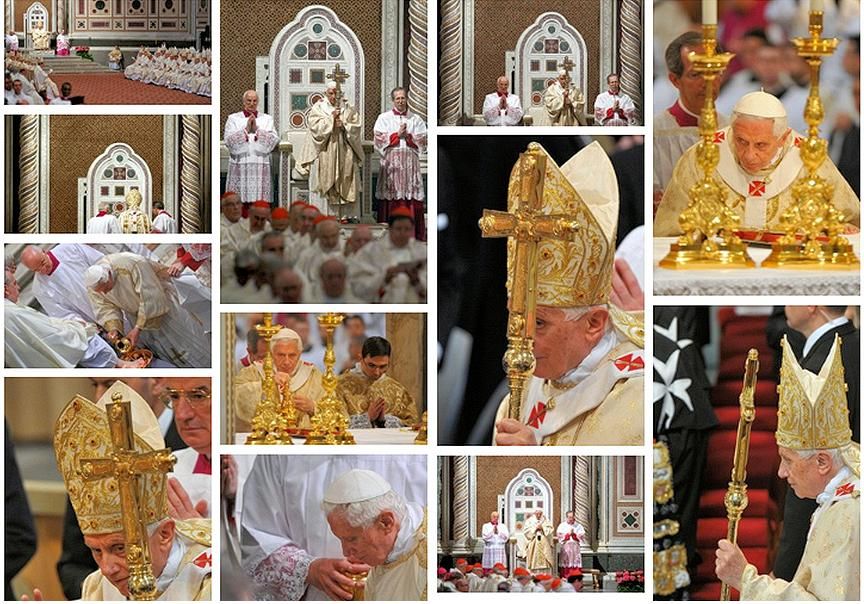 Here is the Vatican translation of the Holy Father's homily:
Here is the Vatican translation of the Holy Father's homily:
Dear Brothers and Sisters!
Holy Thursday is not only the day of the institution of the Most Holy Eucharist, whose splendour bathes all else and in some ways draws it to itself.
To Holy Thursday also belongs the dark night of the Mount of Olives, to which Jesus goes with his disciples; the solitude and abandonment of Jesus, who in prayer goes forth to encounter the darkness of death; the betrayal of Judas, Jesus’s arrest and his denial by Peter; his indictment before the Sanhedrin and his being handed over to the Gentiles, to Pilate.
Let us try at this hour to understand more deeply something of these events, for in them the mystery of our redemption takes place.
Jesus goes forth into the night. Night signifies lack of communication, a situation where people do not see one another. It is a symbol of incomprehension, of the obscuring of truth. It is the place where evil, which has to hide before the light, can grow.
Jesus himself is light and truth, communication, purity and goodness. He enters into the night. Night is ultimately a symbol of death, the definitive loss of fellowship and life. Jesus enters into the night in order to overcome it and to inaugurate the new Day of God in the history of humanity.
On the way, he sang with his disciples Israel’s psalms of liberation and redemption, which evoked the first Passover in Egypt, the night of liberation.
Now he goes, as was his custom, to pray in solitude and, as Son, to speak with the Father. But, unusually, he wants to have close to him three disciples: Peter, James and John.
These are the three who had experienced his Transfiguration – when the light of God’s glory shone through his human figure – and had seen him standing between the Law and the Prophets, between Moses and Elijah. They had heard him speaking to both of them about his “exodus” to Jerusalem.
Jesus’s exodus to Jerusalem – how mysterious are these words! Israel’s exodus from Egypt had been the event of escape and liberation for God’s People. What would be the form taken by the exodus of Jesus, in whom the meaning of that historic drama was to be definitively fulfilled?
The disciples were now witnessing the first stage of that exodus – the utter abasement which was nonetheless the essential step of the going forth to the freedom and new life which was the goal of the exodus.
The disciples, whom Jesus wanted to have close to him as an element of human support in that hour of extreme distress, quickly fell asleep. Yet they heard some fragments of the words of Jesus’s prayer and they witnessed his behavior. Both were deeply impressed on their hearts and they transmitted them to Christians for all time.
Jesus called God “Abba”. The word means – as they add – “Father”. Yet it is not the usual form of the word “father”, but rather a child’s word – an affectionate name which one would not have dared to use in speaking to God.
It is the language of one who is truly a “child”, the Son of the Father, the one who is conscious of being in communion with God, in deepest union with him.
If we ask ourselves what is most characteristic of the figure of Jesus in the Gospels, we have to say that it is his relationship with God. He is constantly in communion with God. Being with the Father is the core of his personality.
Through Christ we know God truly. “No one has ever seen God”, says Saint John. The one “who is close to the Father’s heart … has made him known” (1:18).
Now we know God as he truly is. He is Father, and this in an absolute goodness to which we can entrust ourselves. The evangelist Mark, who has preserved the memories of Saint Peter, relates that Jesus, after calling God “Abba”, went on to say: “Everything is possible for you. You can do all things” (cf. 14:36).
The one who is Goodness is at the same time Power; he is all-powerful. Power is goodness and goodness is power. We can learn this trust from Jesus’s prayer on the Mount of Olives.
Before reflecting on the content of Jesus’s petition, we must still consider what the evangelists tell us about Jesus’s posture during his prayer. Matthew and Mark tell us that he “threw himself on the ground” (Mt 26:39; cf. Mk 14:35), thus assuming a posture of complete submission, as is preserved in the Roman liturgy of Good Friday.
Luke, on the other hand, tells us that Jesus prayed on his knees. In the Acts of the Apostles, he speaks of the saints praying on their knees: Stephen during his stoning, Peter at the raising of someone who had died, Paul on his way to martyrdom. In this way Luke has sketched a brief history of prayer on one’s knees in the early Church.
Christians, in kneeling, enter into Jesus’s prayer on the Mount of Olives. When menaced by the power of evil, as they kneel, they are upright before the world, while as sons and daughters, they kneel before the Father. Before God’s glory we Christians kneel and acknowledge his divinity; by that posture we also express our confidence that he will prevail.
Jesus struggles with the Father. He struggles with himself. And he struggles for us. He experiences anguish before the power of death. First and foremost this is simply the dread natural to every living creature in the face of death.
In Jesus, however, something more is at work. His gaze peers deeper, into the nights of evil. He sees the filthy flood of all the lies and all the disgrace which he will encounter in that chalice from which he must drink. His is the dread of one who is completely pure and holy as he sees the entire flood of this world’s evil bursting upon him.
He also sees me, and he prays for me. This moment of Jesus’s mortal anguish is thus an essential part of the process of redemption.
Consequently, the Letter to the Hebrews describes the struggle of Jesus on the Mount of Olives as a priestly event. In this prayer of Jesus, pervaded by mortal anguish, the Lord performs the office of a priest: he takes upon himself the sins of humanity, of us all, and he brings us before the Father.
Lastly, we must also pay attention to the content of Jesus’s prayer on the Mount of Olives. Jesus says: “Father, for you all things are possible; remove this cup from me; yet not what I want, but what you want” (Mk 14:36).
The natural will of the man Jesus recoils in fear before the enormity of the matter. He asks to be spared. Yet as the Son, he places this human will into the Father’s will: not I, but you. In this way he transformed the stance of Adam, the primordial human sin, and thus heals humanity.
The stance of Adam was: 'Not what you, O God, have desired; rather, I myself want to be a god'. This pride is the real essence of sin. We think we are free and truly ourselves only if we follow our own will. God appears as the opposite of our freedom. We need to be free of him – so we think – and only then will we be free.
This is the fundamental rebellion present throughout history and the fundamental lie which perverts life. When human beings set themselves against God, they set themselves against the truth of their own being and consequently do not become free, but alienated from themselves.
We are free only if we stand in the truth of our being, if we are united to God. Then we become truly “like God” – not by resisting God, eliminating him, or denying him.
In his anguished prayer on the Mount of Olives, Jesus resolved the false opposition between obedience and freedom, and opened the path to freedom. Let us ask the Lord to draw us into this “yes” to God’s will, and in this way to make us truly free. Amen.
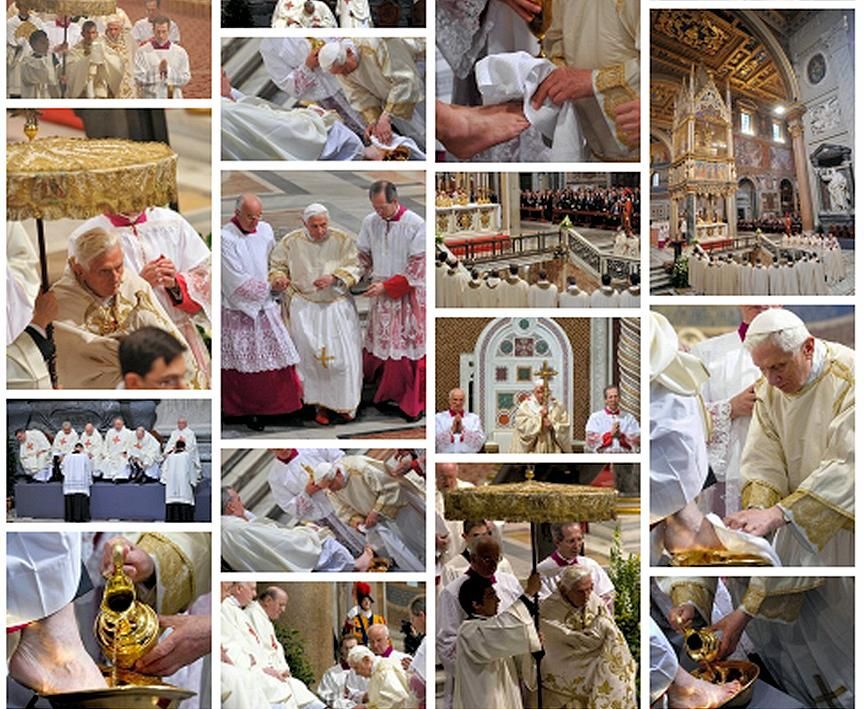
[Modificato da TERESA BENEDETTA 20/04/2014 05:14] |
| |
 06/04/2012 02:24 06/04/2012 02:24 |
|
| | | OFFLINE | | Post: 24.607
Post: 7.141 | Registrato il: 28/08/2005
Registrato il: 20/01/2009 | Administratore | Utente Master | |
|
 Here's an appropriate Maundy Thursday story from the taxpayer-funded US National Public Radio...
Are Israel and the Holy See
Here's an appropriate Maundy Thursday story from the taxpayer-funded US National Public Radio...
Are Israel and the Holy See
close to agreement for the Church
to take control of the Cenacle?
by Daniel Estrin

April 5, 2012
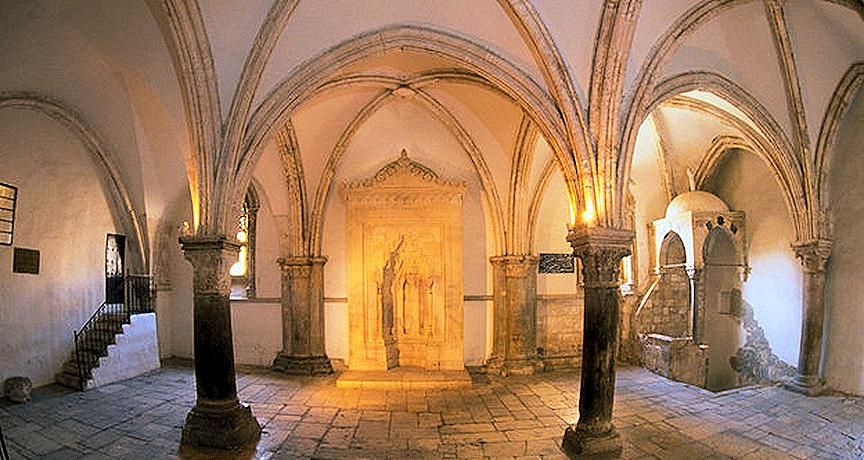 The niche in the center is the mihrab, set in the middle of the wall that indicates the direction of Mecca, and therefore the direction towards which the Muslim must pray.
The niche in the center is the mihrab, set in the middle of the wall that indicates the direction of Mecca, and therefore the direction towards which the Muslim must pray.
This room, known as the Cenacle on Mount Zion in Jerusalem, is venerated as the site of Jesus's Last Supper. Jews and Muslims also consider the building to be a holy site, and it has been a source of contention for years. Israel and the Vatican may be nearing an agreement.
So if there's one building in Jerusalem that represents the city's tangle of religions, this is it. The ground floor is a Jewish holy site said to house the tomb of the biblical King David. The second floor is the Cenacle, a Christian holy site, the room believed to be the site of Jesus's Last Supper. On the roof, there's an old minaret from when this place was marked a Muslim holy site.
One building, three religions, decades of property disputes. And the fight isn't over.
Shimon Gibson, an archaeologist from London who has excavated sites connected to Jesus's final week, says he believes the Last Supper — and the burial of King David — happened in other parts of the city. Still, Jews, Christians and Muslims venerate this site.
The building was destroyed and rebuilt a few times over. The original Byzantine church was replaced by the Crusaders.
"You can see pilgrims have left their names on the walls," Gibson notes.
Later it was taken over by Muslim Mamluks.
"You can see a mihrab, indicating that at one point this chapel was once a mosque," Gibson says.
Catholic Franciscan friars took custody in the 14th century; 200 years later, they were kicked out by the Ottoman sultan. After the 1967 Mideast war, Israel took control.
Israeli authorities have wanted to avoid allowing the Vatican to administer any kind of authority over a site that today isn't under the control of the Holy See. So Israel limits organized Christian prayers here to just a few times a year.
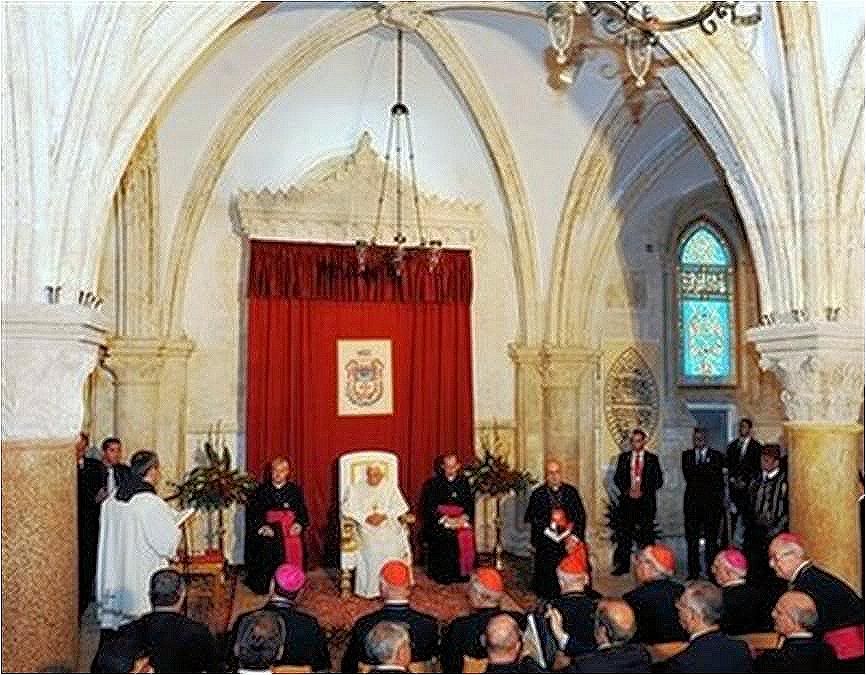 The Cenacle was 'adapted' temporarily for the Vesper service led by by Pope Benedict when he visited there on May 12, 2009.
The Cenacle was 'adapted' temporarily for the Vesper service led by by Pope Benedict when he visited there on May 12, 2009.
There are no crosses on the wall; no chapel. Groups of pilgrims from around the world shuffle in, take snapshots and shuffle out. Sometimes stray cats wander around.
"I am a little bit disappointed, because, yes, I was expecting a place where you can go and pray," says Katharina Iacono of Germany, who sat on a bench in the corner. "It is difficult because [it's] very loud. And with cats and with some smells, it's not very easy."
The Vatican says this building belongs to the church, since friars bought it hundreds of years ago.
"The place is so essential, so much an integral part of the Christian narrative," says the Rev. David Neuhaus, a Catholic vicar in Jerusalem. "Needless to say, it's a dream that we could pray there in regular fashion like other holy places."
It's not the first time in history that Christian prayer here has been limited. In the 16th century, the Ottoman sultan prohibited Christians from the room of the Last Supper.
David's tomb is the main attraction today for devout Jews. Rabbi Avraham Goldstein, who directs a seminary at the site, says he has pleaded with Israeli politicians not to cede any control here.
"The minute they'll make it as a church, Jews, halachically, according to Jewish law, are forbidden to go in there," he says. "It's a disgrace for Israel, you know, it's like milk spilled that you can never return it back."
For two decades, Israel and the Holy See have been trying to work out disputes over church properties in Jerusalem. One of the few remaining thorns is the Last Supper room. Shmuel Ben Shmuel, an Israeli negotiator, says the talks are at a critical moment.
"We don't want to go into all the details right now when we are in the midst of negotiations," he says.
A final agreement could come as early as June.
I had a dismal experience visiting the Cenacle, since one has to pass through the ground floor - where the tomb of David is located - and take the stairs to the Upper Room. The inner courtyard was flooded with rainwater, and one had to walk across planks to get access to the stairs and to the tomb site. The Upper Room is just that - a bare room without any markers, even. But with no other tourists around, it is easy to close your eyes and imagine what it could have been during the Last Supper and then much later, at the first Pentecost, even knowing that the structure itself is certainly not the building where the Christ events happened.
But that was a far better experience than David's tomb downstairs, which was to say the least, disappointing. The first adjective that came to my mind was shabby, and certainly not what I had expected of the shrine of the legendary David, Jesus's ancestor through Mary. [Apparently, this is a sarcophagus into which the Crusaders had safeguarded what was recovered from a medieval site believed to have been David's tomb.] The sarcophagus is situated in a rather small alcove with a not very high ceiling - it's a big rectangular mass that's draped in dark blue velvet with words and symbols in gold thread. Shabbiness and an apparent lack of concern to keep the shrines 'shrine-like' was also what struck me at another major Jewish shrine, Rachel's tomb situated between Jerusalem and Bethlehem and literally in the shadow now of an Israeli garrison and watchtower.
Anyway, for the Cenacle to come back into Catholic hands is something we must pray for. It is too sacred and important a site to be left as neutral space for so long.
 |
| |
 06/04/2012 05:27 06/04/2012 05:27 |
|
| | | OFFLINE | | Post: 24.608
Post: 7.142 | Registrato il: 28/08/2005
Registrato il: 20/01/2009 | Administratore | Utente Master | |
|
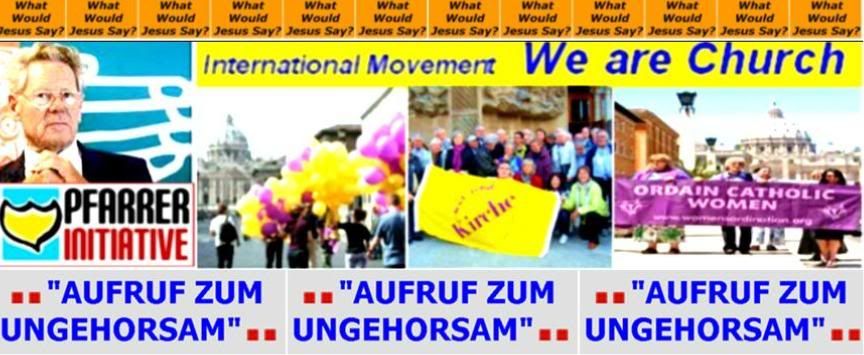 Last year, I devoted at least a couple of significant posts to what is, for me, a hateful 'initiative' (Pfarrer-Initiative) by some dissident Austrian parish priests led by a former auxiliary bishop of Vienna
Last year, I devoted at least a couple of significant posts to what is, for me, a hateful 'initiative' (Pfarrer-Initiative) by some dissident Austrian parish priests led by a former auxiliary bishop of Vienna
I have lumped the priests in the banner above with Hans Kueng and We are Church as the epitome of the progressivist dissident movement in the Church. 'Aufruf zum Ungehorsam' is the priests' 'Call for Disobedience'. [BTW, since I used the dissident groups' own materials to put together the composite, isn't their choice of colors simply lurid?]...
Their manifesto (rather brief but incredibly in-your-face) can be found on this post, with other related material...
http://benedettoxviforum.freeforumzone.leonardo.it/newpost.aspx?a=edit&c=169318&f=169318&idc=657879&idd=8527207&idm=112222487&p=228
In a perverse way, the Austrian dissident priests are apparently celebrating the fact that Pope Benedict XVI has given them the spotlight today,trusting in the trite truism that any news is good news... .
Dissident priest leader
welcomes Pope's words

VATICAN CITY, April 5 (Translated from TMNews) - The Pope has broken his silence on the dissidence generted among some European Catholic priests and in his homily at the Chrismal Mass on the morning of Maundy Thursday, he spoke openly of the call for disobedience issued by some Austrian priests to the alarm of the Church hierarchy.
Benedict XVI's tone was discursive, as is usual for the theologian-Pope, but his conclusions are a doctrinal closure to the ecclesiastic reforms proposed by the rebels starting with women priests. [It must be recalled that this Pope has often said that such 'structural' reforms are meaningless - unless each of us, especially priests, start with personal reform in terms of genuine conversion and purification, and then everything else will fall into place. That is to say, a purified Catholic conscience would see the incompatibility and outright contradiction to the faith of proposing practices that the Church has avoided out of principle.]
But the priest who heads in the initiative, in a phone interview with TMNews, welcomed what he called Benedict XVI's 'openness' - that the Pope had acknowledged the good faith of his group, and although he also made clear the impossibility of changing the Church Magisterium, welcomed the fact that that the Pope has taken a public position [Excuse me, he has always taken a public position on the issues raised by the dissidents - the only difference this time is that he specified a group, even without calling them by name!], and he thinks it is because their reform demands have 'infected' other countries, starting with Ireland after having been shaken by the sex-abuse scandal. [The man is inhabiting a hallucinatory world and taking credit for a phenomenon that is 50 years old. His group's demands have been around since Vatican II - it's not as if the Pfarrer-Initiative was a milestone in protest. Since Vatican-II, dissident priests have been found in every country, though perhaps none of them have found the fertile ground that the Austrian priests have in what was once a most orthodoxly Catholic nation.]/DIM]
[The report goes on to quote what the Pope said in his homily about 'a group of priests in a European country'.]
The 'Pfarrer Initiative' was first launched in 2006 by Mons. Helmut Schueller, now 59 and parish priest of St. Stephan church in the village of Probstdorf. He was once president of Austrian Caritas and a vicar-general of Cardinal Christoph Schoenborn in the Archdiocese of Vienna. [The movement languished for a while until it was re-launched online in June 2011.]
After serving in the archdiocese, he published a 'call for disobedience' which demanded, among others, for women priests, communion for remarried divorcees, abolition of priestly celibacy, and a greater role for laymen in the sacramental life of the Church.
The passage that the Pope devoted to the theme of disobedience was detailed and dense with questions, as befits a man of the Church who does not shirk thorny questions.
Is disobedience a path of renewal for the Church? We would like to believe that the authors of this summons are motivated by concern for the Church, that they are convinced that the slow pace of institutions has to be overcome by drastic measures, in order to open up new paths and to bring the Church up to date.
But is disobedience really a way to do this? Do we sense here anything of that configuration to Christ which is the precondition for true renewal, or do we merely sense a desperate push to do something to change the Church in accordance with one’s own preferences and ideas?
But let us not oversimplify matters. Surely Christ himself corrected human traditions which threatened to stifle the word and the will of God? Indeed he did, so as to rekindle obedience to the true will of God, to his ever enduring word.
His concern was for true obedience, as opposed to human caprice. Nor must we forget: he was the Son, possessed of singular authority and responsibility to reveal the authentic will of God, so as to open up the path for God’s word to the world of the nations.
And finally: he lived out his task with obedience and humility all the way to the Cross, and so gave credibility to his mission. Not my will, but thine be done: these words reveal to us the Son, in his humility and his divinity, and they show us the true path.
Let us ask again: do not such reflections serve simply to defend inertia, the fossilization of traditions? No.
Anyone who considers the history of the post-conciliar era can recognize the process of true renewal, which often took unexpected forms in living movements and made almost tangible the inexhaustible vitality of holy Church, the presence and effectiveness of the Holy Spirit.
And if we look at the people from whom these fresh currents of life burst forth and continue to burst forth, then we see that this new fruitfulness requires being filled with the joy of faith, the radicalism of obedience, the dynamic of hope and the power of love.
"Thus disobedience is not the way, but neither is it hardening," says an editorial by Giovanni Maria Vian in the Friday issue of L'Osservatore Romano, who said that in his homily today, the Pope had delivered "a lucid and kind reflection which once and for all should cancel the stereotype of a weak Pope who cannot govern the Church". [I take issue with the way Vian states this. What stereotype? Marco Politi and other detractors have only lately begun this line of attack against the Pope, drawing ammunition from their exaggerated extrapolation of the relatively minor Curial peccadilloes disclosed by the puny Vatileaks, and completely ignoring that they have said this, and worse, of the Curia under other Popes (in the case of John Paul II, he was accused of having no interest in the Curia at all because he was more interested in his global role). In other words, the idea of Benedict XVI as a Pope who cannot govern has not been bandied about long enough to become a stereotype! Why should the editor of the Vatican newspaper lead in calling the notion a stereotype?]]
Questioned by TMNews, Mons. Schueller commented that the Pope's explanation was 'open' and therefore he sees a half-full glass.
"The Pope recognizes that we are acting out of concern for the Church andfor its future. But he cites John Paul II who said that the Magisterium cannot be modified on questions like women priests. We, and many faithful, do not agree with this. In the course of centuries, the Church has changed its teaching on many points". [Name one! The interviewer should have pressed him on this.]
"Overall, hweover," Schueller added, "The Pope's tone was not harsh". [He never is!]
He claims that more than 400 Austrian priests have signed his Call to Disobedience - about a tenth of them, but that according to a recent poll, 72% of Austrian priests 'sympathize' with his movement.
But above all, he cites how the movement has gone beyond Austria, citing besides Ireland, Germany, Slovakia, Australia, the USA, Latin America and Africa. [You are mixing up countries and continents, Monsignor! That's a dishonest ploy to make your 'influence' seem much wider than it is. I am sure that such dissident priest groups existed in those other places (except Ireland) independent of, and long before, his initiative! ]
"It's probably this internationalization that forced Ratzinger to face the problem of Austrian disobedience publicly for the first time". [Schueller really likes to take credit for too much. How about the Pope spoke out against them specifically because he has realized he can no longer count on the Austrian bishops to hold the line for the faith, because they have shown nothing all this years but an increasing inaction and impotence, and no spine at all, starting with the president of the Austrian bishops conference, the endlessly pandering Count von Schoenborn and Archbishop of Vienna.]
Schueller nonetheless finds its significant that the Pope has not threatened the group with excommunication. [Like he would ever make a threat in a homily on Maundy Thursday! Besides, the Church is prudent with potentially schismatic groups. It negotiated for quite a time with the Lefebvrians before they decided to go ahead and perform an unequivocally and prima facie excommunicable action - ordaining their own bishops without the approval of the Pope, in fact against his express prohibition.]
"The Pope is aware", he said, "that here in Austria, those topics are very much under discussion and that our ideas are followed by many if the faithful. [Hey, popular ideas are not always necessarily right - and the popularity of wrong ideas does not make them right! Besides, the Magisterium is not decided by popular vote, nor was it ever meant to be.] And that therefore the dispute cannot be resolved by sanctions".
In Vienna, Cardinal Schoenborn welcomed the Pope's words as 'an encouragement for the Austrian Church'. [Yes, but what is the 'Austrian Church' today but apparently a loose and unruly aggrupation of dissidents and do-as-you-please Catholics who have lost all sense that religion is necessarily a discipline? 'Encouragement' for them means pursuing their dissent more vigorously!]
Schoenborn - who recently decided uphold the election of a practising homosexual to a parish council over the objection of the parish priest and despite the failure of the candidates to sign a required statement professing adherence to Catholic teachings - has been very active in recent months in seeking to repair what he himself fears to be a potential schism.
Last January 23, as Guido Horst reported in Vatican Insider, Schoenborn along with the bishops of Salzburg, Graz and St. Poelten, came to Rome to meet with officials at the Secretariat of State and the Curia to consider what to do about the Schueller initiative. The Pope is also said to have discussed the 'disobedience' challenge when he met the Austrian Foreign Minister last September.
At the same time, the Archdiocese of Vienna has announced a new book coming out by a Viennese theologian, Jan-Heiner Tueck, which will have contributions by both Schoenborn and Schueller. [What is it that Benedict XVI continually reminds theologians? That they must write first of all with the attitude of 'sentire cum Ecclesia', not proposing what they wish but what the Church does teach.]
In Ireland. the dissident Association of Catholic Priests, which now claims a membership of 600, confirmed that their leader, Fr. Tony Flannery, is "under investigation by the Vatican" for the positions he has publicly taken and has stopped writing a column for the monthly magazine, Redemptorist Reality.
It will be recalled that among the conclusions drawn by the bishops who carried out an apostolic visitation of some dioceses, seminaries and religious orders in Ireland, was this:
Since the Visitators also encountered a certain tendency, not dominant but nevertheless fairly widespread among priests, Religious and laity, to hold theological opinions at variance with the teachings of the Magisterium, this serious situation requires particular attention, directed principally towards improved theological formation. It must be stressed that dissent from the fundamental teachings of the Church is not the authentic path towards renewal".
[Foreshadowing what the Pope said in his homily this morning!]
Now, let me indulge in a re-post of this Oct. 13, 2011, post of the reaction by a Houston professor of theology to the Austrian' 'initiative', and some of my rejoinders at the time:
The Austrian Priests’ Initiative
By Randall Smith

Oct. 13, 2011
I was glancing at the British journal The Tablet the other day and came across an editorial on something called “The Austrian Priests’ Initiative.” [The exact translation of 'Pfarrer-Initiative' is 'Parish Priests' Initiative', by which I suppose the core group intended to underscore that it wasn't just an initiative that originated from ordinary priests but from parish priests, no less.]
“That’s nice,” I thought. “Priests taking initiative.” It quickly became clear, however, that these aren’t exactly priests eager to take on more. Indeed, as far as I can tell, they seem eager to shed the really challenging part of their job: namely, dealing with sin.
According to The Tablet: “The Church has been in turmoil since more than 300 priests led by Mgr. Helmut Schüller called for disobedience on matters such as priestly celibacy and Communion for re-married divorcees.”. [Yeah right, so much 'in turmoil' that the Archbishop of Vienna and president of the Austrian bishops' conference only had only one thing to say to them: 'Disobedience is a No-no! But if we sit down and dialog, we can work things out!" (exactly what the German bishops have been telling their own dissidents), without going into the doctrinal and theological fallacies that the priests advocate!" BTW, I don't know if the Tablet identified the movement more fully in its write-up, but it is emblematic of the dissenters within the Church that the Austrian manifesto is entitled 'A CALL TO DISOBEDIENCE'. If the Tablet did not mention that, then it is guilty of trying to 'soften' the profile of their fellow progressivists in Austria.]
By “the Church,” I take it they mean the “Austrian Church,” since the whole business hasn’t really rocked my world. Where I live, Mass is still being celebrated and confessions are still being heard.
Be that as it may, The Tablet goes on to add that: “The priests are drawing attention to the wide and growing disconnection between the norms of official church teaching, and everyday Catholic life as lived by many of the clergy and laity. Issues raised include birth control, Holy Communion for the divorced and remarried, priestly celibacy, and the treatment of homosexuals.”[And media outlets like the Tablet perpetrate this 'growing disconnection' by playing up the discontents into a vicious spiral of 'nattering negativism', as one Spiro Agnew once baptized MSM's adversary journalism.]
Why always the same old list: birth control, celibacy, homosexuality, divorce, and remarriage (a.k.a, “how to replace your old, annoying, unsexy wife with a newer, sexier model”)? Is there nothing these priests can think about other than sex?
How about greater support for Catholic parents who are struggling to raise six kids? How about better civic values and concern for the common good? How about better pay for teachers in Catholic schools and nothing less than a first-rate education for all Catholic school children? Nope. Just sex. [Perhaps the pathology of the malcontents begins there - that they view everything through the prism of sex, a monomania that is a sickness in itself. Which shows they never should have become priests at all. It is the height of dishonesty - to oneself above all - to spend all that time training to be a Catholic priest knowing in your heart that you will probably never be able to reconcile yourself with the vow of celibacy that Catholic priesthood entails.
Someone like Joseph Ratzinger, at the age of 69, was honest enough to speak to an interviewer [Salt of the Earth, 1996, pp 55-56) about the hours he spent asking himself before his ordination "whether I really could relate to people... lead and inspire young people, instruct kids, deal with the old and the sick, whether I would be able to do that all my life" and "whether I would be able to remain celibate, unmarried my whole life long". Adding that the latter was a practical problem since during the last two years of his studies at the theological faculty attached to the University of Munich, postwar conditions meant that "male and female students lived at such close quarters that the daily encounter definitely made the question of renunciation and its inner meaning a practical one".
No aspiring priest can nor should make the decision lightly, but once he has made that decision, he should do his best to live by it. After all, no one forced him into the decision - and I don't suppose any of the Austrian priests involved in the 'initiative' was subjected to force majeure to become a priest!]
These priests must imagine that all of us who are married are getting sex all the time. I hate to disappoint them, but modern women tend to take a rather dim view of husbands who think of their wives as regular sex machines. If you’re not ready for celibacy, guys, you’re probably not ready for marriage.
“What Catholics hunger for,” says The Tablet, “and not just in Austria, is a Church of integrity, without hypocrisy, doublespeak or pathological denial.” [Implying, of course, that those attributes describe the Church today!]
If by that they mean people should practice what they preach, then absolutely. If they mean people should stop preaching what’s hard to practice, well then, that’s just silly. Nobody ever said Christianity was going to be easy.
When surveys come out trumpeting that such-and-such a percentage of Catholics don’t practice what the Church teaches on, say, contraception, I feel like pointing out to them that 100 percent of Catholics don’t practice what the Church preaches about loving their neighbor as themselves, forgiving as they have been forgiven, not stealing, and not coveting their neighbor’s possessions. (Once you throw “coveting” in there, things get really dicey, don’t they?)
In addition, 100 percent of Catholics don’t consistently care for the poor or live up to the demands of the Beatitudes. So should the Church “bow to reality” and dump those things too, because they’re hard? Look, if only 40 percent of Catholics are failing to live up to the Church’s teaching on contraception and conjugal union, then I’d say we’re still about 60 percent ahead.
What exactly are these priests thinking? I assume nearly everyone is going to be stuck in the rut of sin pretty much every day. That’s why I find accusations of “hypocrisy” a bit odd.
If going into a Catholic church were a public proclamation of being sinless, then, yes, we’d all be hypocrites. But since I take it that going to church implies: “I’m a sinner who wants to do better, in need of the forgiveness of Jesus Christ,” then charges of “hypocrisy” are simply misplaced. Catholics don’t claim to be perfect. People who aren’t sick don’t need a doctor.
As for the “disconnection between the norms of official church teaching and everyday Catholic life” the Tablet is worried about, let me be the first to admit to a pretty healthy distance in my life between theory and practice. I call the gap between the two: “sin.”
The theory is: “love my neighbor as myself.” But I act like a selfish jerk. That’s precisely why I need a priest who’s willing to go through that struggle with me, not one who finds the messy business of dealing with sin just too. . .what?. . .unsophisticated?
This business in Austria seems pretty serious. One headline called it “Austria’s Moment of Truth.” Another talked of “schism.” Wow. Schism. Really? Over what?
In centuries past, people argued over deep theological issues such as the nature of Christ, the Trinity, and the sacraments. These priests seem willing to walk away from a two-thousand-year-old Church because it teaches that a married couple shouldn’t turn fertility into a pathology that needs to be treated with drugs or sterilized with the sexual equivalent of a latex surgical glove.
But look, if these priests feel they have to walk away, God go with them. Being a priest and dealing with sin is admittedly hard. No one can force you to do it. Just one thing, though: If you leave the Church, guys, leave the church.
Schismatics somehow think they get to keep the beautiful buildings. Gentlemen, the places where you live and work were built over centuries by generations of faithful men and women dedicated to principles you now reject.
The buildings don’t belong to you just because you’ve lived in them for a precious few years. You were merely holding them in trust for the next generation. If you no longer wish to carry on the tradition handed down to you, fine. Walk away if you must. But please, go build your own churches. We’d like ours back.
{Actually, none of them have any intention of walking away! What they expect is for everybody else to leave the 'institutional' Church and rush to join their initiative. What are they, though? Other than a ragtag band of ideologues who have forgotten that God is supposed to be the center of Church life, not they and their bloated flatulent egos. Do they really think they can inspire spirituality in anyone when they lack it themselves?]
Just for background, here are the statistics about the Church in Austria provided by the Vatican at the time of the Pope's visit there in 2007:
Population - 8,220,000
Catholics - 5,976,000
Catholics as % of population - 72.7%
Ecclesiastical districts - 12
Parishes - 3,072
Other pastoral centers - 1,002
Catholics per pastoral center - 1,467
And here are the Pfarrer-Initiative's membership as their website shows it today (10/14/11):
Members: 338 priests and deacons (56); median age 58.8
Supporters: 69 priests and deacons (4); median age 58.6
Supporters: 1004 lay faithful; median age 50.2
Considering that Austria had more than 3,000 parishes in 2007, the participation rate in terms of member priests is 338-56 = 282 parish priests, or less than 10% of the parishes. Why the other 65 priests are merely listed as supporters not members, once can only guess. And what does it say that they have only managed to attract 1004 lay supporters in seven-plus months ? Perhaps 1004 is the true number of 'We are Church' activists in Austria today, because otherwise, if they had tens of thousands, or even millions as they claim, they would have taken over St. Stephen's Cathedral in Vienna by now and kept Cardinal Schoenborn hostage...
And note the median age of the participants! The priests are nearing 60 years old, which means they began seminary studies around the end of Vatican II, while the laymen were toddlers at around that time. So guess what was their primary if not exclusive experience of the faith? Certainly not the faith of our fathers, as in Fathers of the Church, but the faith of the progressivist Vatican II fathers which seems to be much closer to Protestantism than to Catholicism - but apparently without Martin Luther's continuing zeal for God and his grace!
I don't doubt that the dissidents probably have many more sympathizers out there among their fellow priests who just do not want to come out into the open. But if the 'movement' were so compelling, would it not have spread like wildfire by now? Beware of being taken in by the generalizations of liberal mouthpieces like the Tablet who always blow up any dissent against the Church as if it were the definitive tsunami that is about to sink the whole Church, Pope and all.]
[Modificato da TERESA BENEDETTA 06/04/2012 15:40] |
| |
 06/04/2012 16:46 06/04/2012 16:46 |
|
| | | OFFLINE | | Post: 24.609
Post: 7.143 | Registrato il: 28/08/2005
Registrato il: 20/01/2009 | Administratore | Utente Master | |
|
 April 6, GOOD FRIDAY
April 6, GOOD FRIDAY
 The Crucifixion, from left: Giotto, 1304-1305; Masaccio, 1426; Michelangelo (sculpture), 1492; Raphael, 1502; and Van der Weyden, Entombment of Christ, 1451.[
The Crucifixion, from left: Giotto, 1304-1305; Masaccio, 1426; Michelangelo (sculpture), 1492; Raphael, 1502; and Van der Weyden, Entombment of Christ, 1451.[
Readings for today's liturgy:
usccb.org/bible/readings/040612.cfm
THE POPE'S DAY
17:00 CAPPELLA PAPALE
Celebration of the Passion of the Lord
St. Peter's Basilica
- Liturgy of the Word
- Homily by Fr. Raniero Cantalamanessa
- Adoration of the Cross
- Communion
21:15 Way of the Cross
Roman Colosseum
- Concluding remarks by the Holy Father
[Modificato da TERESA BENEDETTA 06/04/2012 20:42] |
| |
 06/04/2012 18:47 06/04/2012 18:47 |
|
| | | OFFLINE | | Post: 24.610
Post: 7.144 | Registrato il: 28/08/2005
Registrato il: 20/01/2009 | Administratore | Utente Master | |
|

 Cuba marks Good Friday
Cuba marks Good Friday
as a public holiday

April 6, 2012
Communist Cuba is marking Easter with a public holiday on Good Friday, for the first time in decades.
This follows Pope Benedict's visit to the country last week, where he requested the move.
Religious holidays in Cuba were cancelled after the 1959 revolution, and fewer than 10% of Cubans are practising Catholics.
Nonetheless, the Church is the most influential organisation outside the Communist government.
The Cuban government said it granted the request as a mark of respect, and to commemorate the "transcendental nature" of the pope's visit.
The Pope's predecessor, John Paul II, made a similar request before the last papal visit to Cuba in 1998, successfully persuading then-leader Fidel Castro to recognise Christmas as a public holiday.
A service at Havana Cathedral will be broadcast live on Cuban television, indicating the improving relations between the Church and the government, says BBC Havana correspondent Sarah Rainsford.
Religious or not, Cubans have welcomed the day off, and hope that the change will be permanent, our correspondent says.
Some described it as a sign that Cuba was opening up to the world.
"I think almost all Cubans think it's a very good idea," one told the BBC.
The holiday has only been declared for this year, but the government says it will take a decision later on whether to make it permanent.
Guess what! Not all is grim
and hopeless in Cuba -
the Washington Post tells us
Having just read a generally depressing post-B16 visit in Catholic World Report on line by a propagandist for the Cuban dissidents, it was almost providential that the next article I came across was this surprisingly upbeat report in the Washington Post, of all places. It is an article I certainly did not expect to find in one of the top international MSM opinion-purveyors, who have always depicted the Cuba story in stark black-and-white, admitting no grey tones whatsoever, and seeing not a single redeeming feature for Cuba. So, who cannot welcome a report such as this? For sure, we know the Washington Post is not shilling for the Castro regime, so this is no puff job for anyone... One can almost be sure reports like this were and are being conveyed to the Pope by his bishops in Cuba, along with the negatives.
Soon after Pope's visit,
Havana church hosts meeting
with former hard-line exiles
By William Booth

Friday, April 6, 2012
HAVANA — The setting was historic. The looming 18th-century Seminary of San Carlos in Old Havana. The attendance remarkable. A hall packed with professors, dissidents, clergy, bloggers, leftists, diplomats. The subject matter once unthinkable.
Just after Pope Benedict XVI left Cuba last week, the Catholic Church hosted a talk by Miami millionaire Carlos Saladrigas, who politely but directly said here in a public forum that socialism — the bedrock of the revolution — wasn’t working anymore on the communist-run island.
After his first visit to Mexico, Pope Benedict stopped in Cuba, formerly an officially atheist country.
“To be honest,” Saladrigas said later, “who could have thought such a meeting possible? Not me. Never.”
But the meeting was clearly a sign that there is cautious but visible change on the island.
Saladrigas, a Cuban exile entrepreneur and former hard-liner who has flourished in Miami, said that “big changes in the next few years” were inevitable, and he advised young Cubans to stay put.
Although Saladrigas said that Cuba’s state-run economy needed to be opened to free enterprise, the 63-year-old investor also blamed the U.S. government and the anti-Castro Cuban exiles and their politicians in South Florida for perpetuating a standoff that has hurt Cubans on both sides of the Florida Straits.
“Change is not easy, I know this personally,” he said.
“This was an event of tremendous importance, the first time that a prominent Cuban from aboard could express these thoughts in a large forum,” said Oscar Espinosa Chepe, an independent Cuban economist who attended the meeting. He remarked that Saladrigas and the dozen people who stood at the microphone criticized both the Cuban and U.S. governments — and even offered a few solutions — in voices respectful and calm.
There were tough questions, too, directed at Saladrigas. Participants asked how the Miami exiles could really help Cuba while still supporting the 50-year-old embargo. The questioners wanted to know how U.S.-style capitalism could replace Cuban socialism, without turning workers into wage slaves and leaving the most vulnerable at the mercy of the markets.
In the past three years, President Raul Castro has begun to open the Cuban economy to its citizens. The government now allows small businesses — like car washers, shoe cobblers, pizza makers — to operate, even hire employees, though it restricts the size and ambition of the enterprise.
The streets these days are filled with legal bazaars (and some blackmarketeering) as fledgling entrepreneurs dip their toes into the capitalist stream. Some neighborhoods in Havana look like a perpetual garage sale.
The for-profit produce stalls are piled high with fresh fruits and vegetables; the government bodegas that issue staples like rice, beans and oil still serve as a valuable safety net in a country where the average monthly wage is $25, though they feel less vital and look empty.
The state is trying in fits and starts to trim its unproductive workforce. It is beginning to shutter state-run cafeterias and has even floated the idea of ending ration cards.
Fallow lands have been offered to free-enterprise farmers, though they complain they can’t get access to tractors or fertilizers. Citizens can now buy and sell their cars — just not new cars — and their homes, too.
Although the Internet is limited and mostly dial-up slow, there are 1.5 million cellphones. Just a few years ago, ordinary citizens were barred from owning them.
Under Castro, the government is also allowing more space for criticism — though not dissent. One of the main beneficiaries of that change is the Catholic Church, which is providing community outreach programs, offering the kinds of services — breakfast for the elderly, free pharmacies, and computer, business and English classes — that were once the sole responsibility of the state.
Today the Church and the government appear to be working side by side. When he was in Cuba last week, the Pope pressed for more religious freedom. The Vatican wants the Church to be able to run schools and hospitals here. There was no official response to the request. But Castro did grant the Pontiff one wish — the government declared Good Friday a paid holiday.
If Havana is changing, so too is Miami.
When Pope John Paul II came to Cuba in 1998, it was Saladrigas who organized mass demonstrations — and backroom arm-twisting — that led the Catholic Church in Miami to cancel plans to charter a cruise ship to bring South Florida pilgrims to the island to greet the pope.
Saladrigas now says he was wrong, and he vowed not to make the same mistake twice. In the past year, with sponsorship from the Church, the Cuban government has awarded Saladrigas four visas to visit the island. (In the years proceeding, he was turned down eight times).
Last week the Catholic church in Miami brought 800 pilgrims in five planes to Cuba to celebrate Mass with the Pope, led by the Archbishop Thomas Wenski.
The exile community in Miami has more confidence in the Catholic Church in Cuba to act as a force for positive change, Wenski said, to help negotiate a “soft landing” as Cuba makes the inevitable transition to post-Castro realities. [That's not what we are told by the dissidents and their propagandists - which include all of MSM that I have read so far, other than this article - who consider Cardinal Ortega to have sold out to the regime for minor concessions to the Catholic Church, and who claim that the Church is doing nothing for the dissidents - despite the fact that Cardinal Ortega secured the release of many political prisoners and continues talking with the regime for further releases.]
“Of course, not everyone wants a soft landing. Some people want chaos and bloodshed and civil war,” Wenski said, “but those people are in the minority now.”
Wenski said that the Pope’s visit advanced everyone’s cause, at least a little bit. “Everyone needs the Church in Cuba, even Raul. Maybe especially Raul.”
Joe Garcia, the former director of the conservative Cuban American National Foundation, based in Miami and Washington, said that opponents of the last Pope’s visit learned that they missed an opportunity to engage.
“This time there was no real opposition. In Miami we saw the visit by the Pope as mostly a good thing, not great, but good,” Garcia said. “Though of course there were a few people who wanted to see the Pope get off the plane like Rambo and take out the leadership.”
Garcia said people in Miami were mostly disappointed the Pope did not meet with dissidents on the island, and that the Pontiff did not speak directly to the harassment they faced. [I think that is, for once, an honest description of what the dissidents in Cuba have had to deal with. Harassment, not persecution - if even Amnesty International no longer has a single 'prisoner of conscience' on its Cuba list, and all the dissidents in Cuba now most vocal against the Pope and the Church have really been free all these past many years to stage their protests and speak to international media.
Of course, there appear to have been a number of arrests and detentions in the days leading up to the Pope's visit, but the detainees were released after a couple of days without charges; and a number of dissidents twitted that they were kept by police from leaving their homes on the day of the Pope's Mass. As objectionable as this harassment is, they appear relatively minor compared to how totalitarian regimes, including the Castro regime in its early years, treat dissidents as a rule.
In the eyes of militant exiles in Miami, Saladrigas was a traitor to the cause, who had gone all soft, with his talk of reconciliation with the Cuban state and society.
Now they are watching him on television.
To the Castro government, Saladrigas once represented the enemy, the conservative, wealthy Miami fat cat, the true gusano, the worm.
Now he is granted visas to visit.
Kudos to the reporter and to the Washington Post for reporting something different that allows us to see another side of the situation in Cuba. It's the kind of 'balancing off' article I was looking for in the days before the Pope's visit but which I never found.
And here's the CWR report by a man who has produced three documentaries on the opposition movement and the Church in Cuba, so his sympathies are obvious. The dissidents had the same expectations of Benedict XVI that he could with a wave of his pastoral staff lift the totalitarian yoke of the Cuban regime, as the Jerusalem rabble had that Jesus as the Messiah would rid the Jews of the Roman imperium...
The continuing struggle for the soul of Cuba
In the wake of Pope Benedict's visit,
Cuban dissidents express frustration and anger
as the Castro regime continues political repression
and religious persecution
by Jordan Allott

April 5, 2012
A day before Pope Benedict XVI’s historic visit to Cuba on March 26, I was in Arroyo Naranjo, one of Havana’s poorest areas, meeting with Lilvio Fernandez Luis, a Catholic and the leader of JACU, or Joventud Activa Cuba Unida.
Lilvio spent the day showing me the life he has worked hard to create — a life built on a strong family and the courage to fight against the repression that the Cuban government has inflicted on its people for more than 53 years.
When I spoke with him, Lilvio wasn’t planning to attend the papal Mass at the Plaza de Revolution in the center of Havana on March 28. “I will attend Mass here at my home parish of St. Barbara just two blocks away,” he explained. “If I try and leave my neighborhood on the day of the Mass, I will most likely be detained by state security.”
Lilvio’s situation was not unique. Although the Church’s goal was to reach out to the Cuban people during Pope Benedict’s visit, many individuals and families found it difficult or impossible to participate in the three days of events organized by the Cuban Catholic Church and Vatican with permission from the island’s Communist government.
Despite the government’s limitations, however, Lilvio and almost everyone I talked to during my time in Havana believed the Pope’s trip would be a positive spiritual experience, if not a positive political experience, for the people of Cuba.
Throughout the past five decades, the Communist government of Fidel and Raul Castro has consistently repressed institutions and organizations not under their strict control.
Soon after the 1959 revolution, Fidel Castro declared Cuba an atheistic state and reduced the Church's ability to work among the people by deporting hundreds of priests and nuns, seizing all Church properties, and imprisoning and executing countless Catholics and others who expressed faith in God. As the decades passed, Christians continued to face severe discrimination.
After the fall of the Soviet Union, however, the Cuban government felt the need to ease up on its repression against the Church in order to receive economic concessions from Europe—aid it had previously received from the USSR. In 1992, Cuba declared itself a secular state and permitted Catholics and others to join the Communist Party, the country’s only legal political party.
In 1998, Pope John Paul II made a historic visit to Cuba. It was Cuba’s first papal visit, and the trip ignited hope amongst those who remembered John Paul II’s journeys to his native Poland (then Communist) in 1979. The Pope’s visits helped initiate the Solidarity Movement that ultimately contributed to the collapse of the Soviet Union.
During his five-day visit to Cuba, Pope John Paul II held meetings with Fidel Castro and religious leaders, and celebrated public Masses in several cities. John Paul II spoke often about the nation’s need for individual responsibility, strong families, and a culture of life.
With his visit, Pope John Paul II brought spiritual hope not only to Roman Catholics, but also to the many other Christians and non-believers who attended the various public Masses and celebrations.
But certain topics were off limits during the Pope’s visit, including any public discussion of Cuba’s political prisoners. Many human rights advocates both on and off the island were disappointed that the Pope did not speak out in support of the opposition movement that had been working for religious freedom and human rights on the island. [The 'convention' uniformly employed by MSM in reporting Benedict's visit was different: that whereas John Paul II spoke forcefully in favor of the dissidents, Benedict XVI chose to do so only indirectly! Which is par for the course, in terms of the unfair and downright false reporting of MSM about Benedict XVI.]
I have traveled to Cuba on a number of occasions over the past few years, and have discussed issues of faith with Cubans from one end of the island to the other. More than in the past, during Pope Benedict’s visit, I found Cubans willing to discuss the restrictions placed on the Church by the government.
“The churches are crumbling and we don’t have permission from the government to make renovations,” Raul, a Catholic from Havana who is involved with his local church, complained. “We cannot communicate with the people because newsletters are restricted and the majority of people have been living a life without God for two or three generations. It’s almost as if we are starting from nothing.”
Raul’s wife, Yinet, agreed. “Starting from nothing and without any resources is very difficult,” she told me.
The Communist government has made small moves to allow the Church some independence over the past decade and a half. Politically, however, the government has continued to deny its people any opportunity for democracy or a say in their own future.
A 2003 crackdown on non-violent human rights and democracy advocates included the imprisonment of 75 men and women from across the island. Many of those arrested received sentences of 25 years in prison. In 2010 and 2011, the Cuban Catholic Church, with help from the Vatican and the Spanish government, negotiated the release and forced exile of most of the prisoners imprisoned during the 2003 mass arrest.
Many Cuba-watchers believe the Church’s new role of mediator is a positive sign, understanding the Church to be the only institution able to communicate with the Communist government from inside the island.
Others fear that the Church has grown too close to the Communist government. They wish the Church would do more to reach out to the dissident community and to speak up more loudly for the political rights of the Cuban people. [Cardinal Ortega has been doing that, to the extent that he can. The Cuban bishops' conference issued a formal statement in 2003 denouncing government repression, yet the Church in Cuba is also realistic enough to know that it can only do so much, and that its primary duty is to safeguard the interests of all Cuban Catholics first, ahead of crusading for the rights of a few hundred dissidents. Moreover, the critical dissidents who have never been imprisoned cannot claim to have any moral superiority over the cardinal who spent two years in a Castro labor camp.]
Pope Benedict’s visit started in Santiago de Cuba on the eastern end of the island with a greeting by President Raul Castro and a public outdoor Mass celebrating the 400th anniversary of the Virgin of Charity. The following morning, Benedict visited the Shrine of Our Lady of Charity in El Cobre, a few miles from Santiago. On his third day in Cuba, Pope Benedict offered a public Mass in Havana’s Revolutionary Square and visited privately with Fidel Castro before returning to Rome.
As Pope John Paul II had done 14 years earlier, Pope Benedict spoke of the need for Cuban society to return to a culture of life. Benedict, whose office cast the trip in the context of a spiritual pilgrimage, at times addressed political issues — often delicately, and on occasion more explicitly.
At the start of his visit, aboard the flight from Rome, he denounced Cuba's Marxist political system, which he said "no longer corresponds to reality." In Santiago de Cuba, he prayed for "those deprived of freedom." And he made several references to freedom in his final sermon in Havana, addressing a nation that has suffered under a totalitarian government routinely denounced for its abuses by international human rights groups.
While these statements and the spiritual solidarity the Pope’s visit brought were felt by many, others felt the Pontiff, the most visible Christian leader in the world, could have done more to press the government concerning human rights, as well as religious and individual freedoms. [The Messiah syndrome, as usual, in which people expect a spiritual leader to lead a political fight when that is not his function, much less his priority.]
Cuba is still designated "not free" by Freedom House, and is still among its "worst of the worst" countries and one of "the world's most repressive regimes." [It would have been helpful if Allott had attributed these judgments to some specific institution, and if he had also mentioned Amnesty International's acknowledgment that as of the beginning of 2012, at least, there was not a single 'prisoner of conscience' left in Cuba's prisons, and that the latest US State Department account said 'no human rights abuses' were reported in its last reportign period which covered the second half of 2012.]
During the Pope’s visit, more than 300 human rights advocates across Cuba were detained in order to keep them from speaking out publicly against the government while the world’s attention was focused on the island.
In fact, three days before Pope Benedict landed in Santiago, I was scheduled to meet with human rights advocate Sara Marta Fonseca outside a popular hotel in the center of Havana. Sara Marta and her husband never showed up for the meeting, and I was later told she had been detained on her way there. She was kept in jail for more than a week, until long after Pope Benedict had left the island.
Traveling around Havana I got the impression that the government was exploiting Pope Benedict’s visit in order to give the impression to outsiders that the government was tolerant of religious institutions.
The visit was also a boon to Cuba’s dismal economy. It seemed to me that more than half of the individuals I saw at the public Mass in Havana were foreigners. Billboards, posters, and other materials advertising the public events were located mainly in tourist hot spots.
In fact, more than one Cuban I talked to who had traveled to Havana from another part of the island told me they were in Havana illegally.
“The government is scared to have us here in Havana,” said Guillermo, who lives with his family outside Santa Clara. “It is illegal for Cubans to move about the island without permission. The government wants control and when people move freely, control is lost.” [But they managed to come, anyway, so good for them!]
The sense of paternalism is evident to outsiders at all times in Cuba, but especially during large events when foreign journalists are present and the outside world is watching.
“It’s as if your parents are expecting an important guest and are afraid the children will make a scene,” Lilvio explained. “They are nervous about how we will act with outsiders around.”
One individual, Andres Carrion Alvarez, undoubtedly expressing the feelings of many, shouted "Down with the Revolution! Down with the dictatorship!" near journalists at the Mass at Santiago's crowded Revolution Plaza. He was beaten and escorted out of the Mass by armed police and hasn’t been seen since. [What we saw on TV was that he was surrounded by three unarmed security men then escorted out of the Mass sector and led away by two man in civilian clothes. Was he beaten afterwards, and is it true he has not been heard from since? We only have Allott's conjecture. This was an episode some Western MSM reporter in Cuba could and should have followed up as a case history of what happens to dissenters who 'make a scene', but I did not see one follow-up report during the two more days that the Pope was in Cuba after the incident.]
In the case of Lilvio, the “parents” decided it was better if their guest did not have the chance to meet him and to hear about the abuse he and his brothers and sisters are suffering. Lilvio was detained the day of the Pope’s arrival.
Many people ask me if much has changed in Cuba over my four years of travel there. Not much, I tell them. There have been some cosmetic changes, such as allowing select individuals to set up small bodega-style restaurants in certain areas of the country.
But the regime is still as committed to “la revolucion” as it ever was. On the way to the airport I saw a sign that underscored the statement of Marino Murillo, vice president of the island's council of ministers.
Responding to the Pope's remarks about the failure of Cuba’s Marxist political system, Murillo said, “In Cuba, there will not be political reform.” Similarly, the billboard announced, “Our changes mean only more socialism.”
Despite the contradictory feelings I experienced over the course of my trip, I was left with one lasting sound from my stay in Havana: that of Pope Benedict’s voice speaking about God, faith, and family, blasting from televisions across the city as I walked Havana’s streets. A welcome voice and needed message, especially in Cuba.
[Modificato da TERESA BENEDETTA 07/04/2012 01:59] |
| |
 07/04/2012 06:22 07/04/2012 06:22 |
|
| | | OFFLINE | | Post: 24.612
Post: 7.145 | Registrato il: 28/08/2005
Registrato il: 20/01/2009 | Administratore | Utente Master | |
|

 GOOD FRIDAY
GOOD FRIDAY
Commemorating the Passion
of the Lord
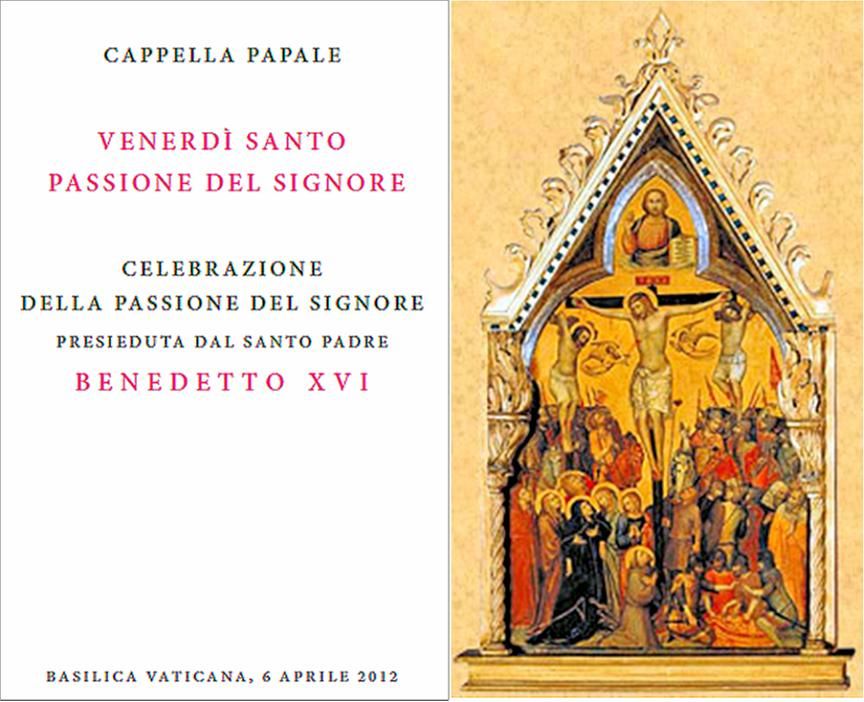 Libretto cover: Detail from Polyptych, Crucifixion and Stories of Christ and the Saints, Matteo di Giovnai, 1340. Sala di Sant'Ambrogio, Vatican Apostolic Palace.
Libretto cover: Detail from Polyptych, Crucifixion and Stories of Christ and the Saints, Matteo di Giovnai, 1340. Sala di Sant'Ambrogio, Vatican Apostolic Palace.
The Holy Father led the Good Friday liturgy at St. Peter's Basilica this afternoon, which consisted of the Liturgy of the Word, in which the Passion of the Lord was recounted according to the Gospel of St. John; the adoration of the Cross; and Communion. It is the one day of the year when Mass is not celebrated.
Liturgy of the Word
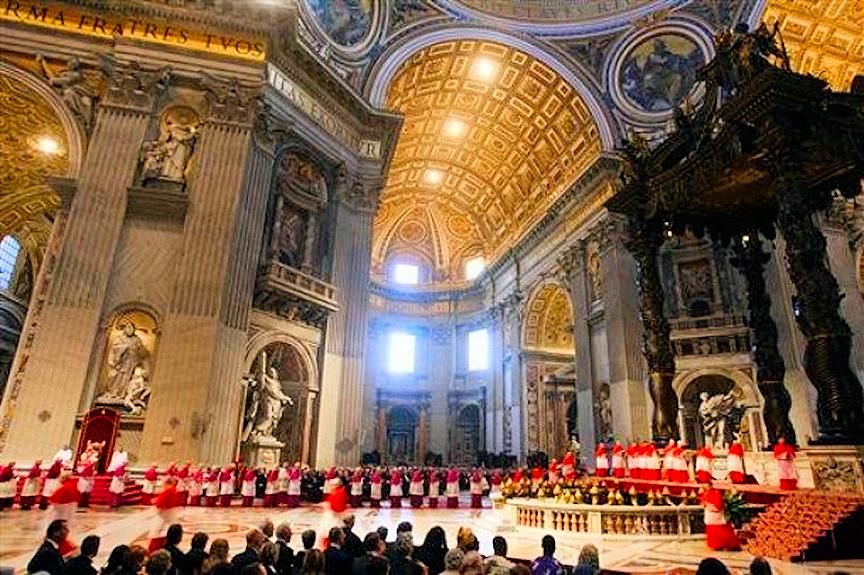
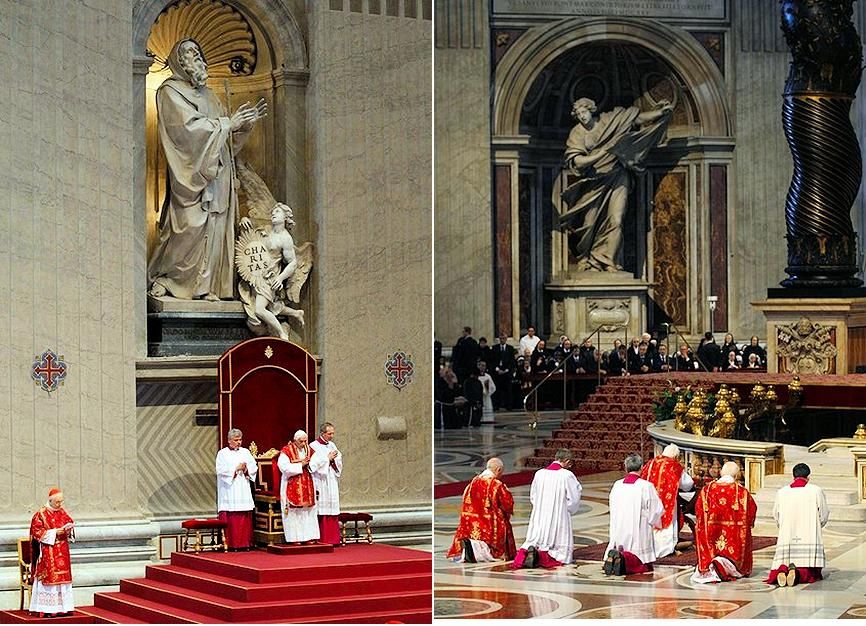

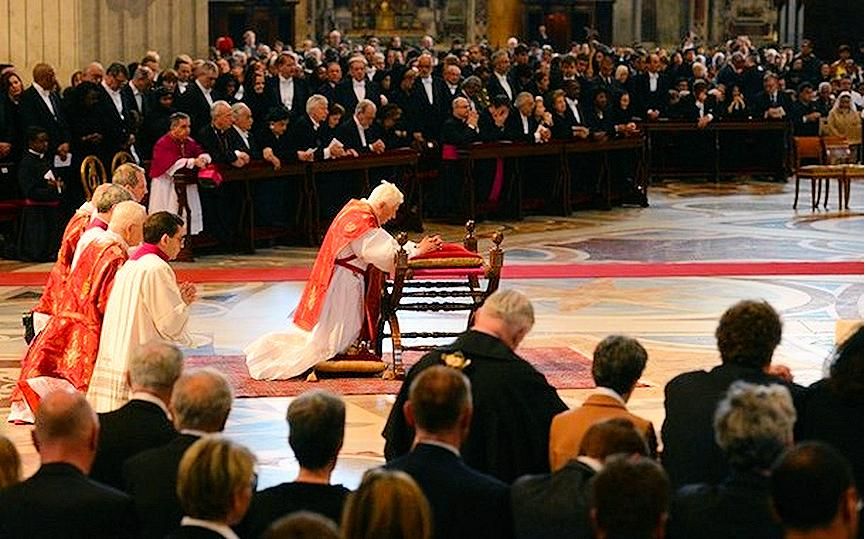
 The homily was delivered, according to Vatican tradition, by the Preacher of the Pontifical Household, Fr. Raniero Cantalamessa.
Adoration of the Cross
The homily was delivered, according to Vatican tradition, by the Preacher of the Pontifical Household, Fr. Raniero Cantalamessa.
Adoration of the Cross
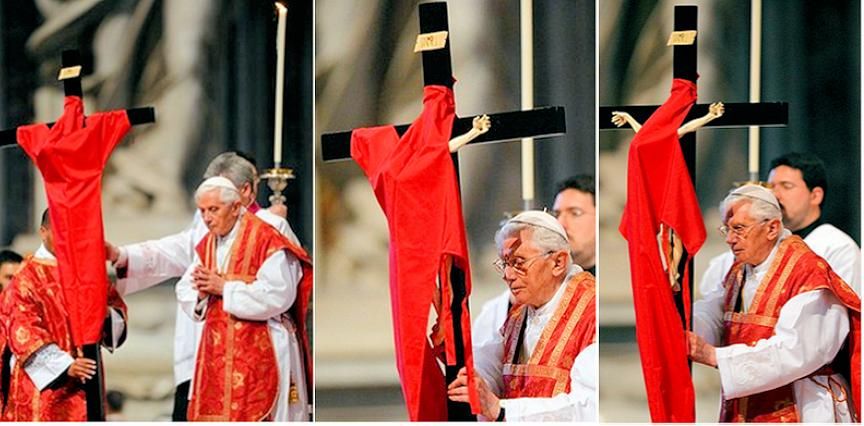 The Cross is uncovered in three stages - one arm at a time, and then, the entire figure of the crucified Lord.
The Cross is uncovered in three stages - one arm at a time, and then, the entire figure of the crucified Lord.


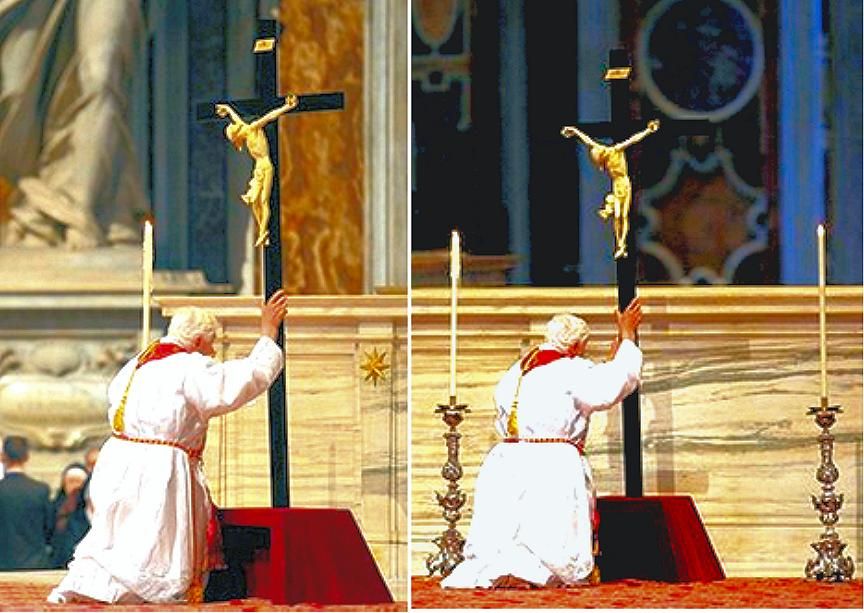
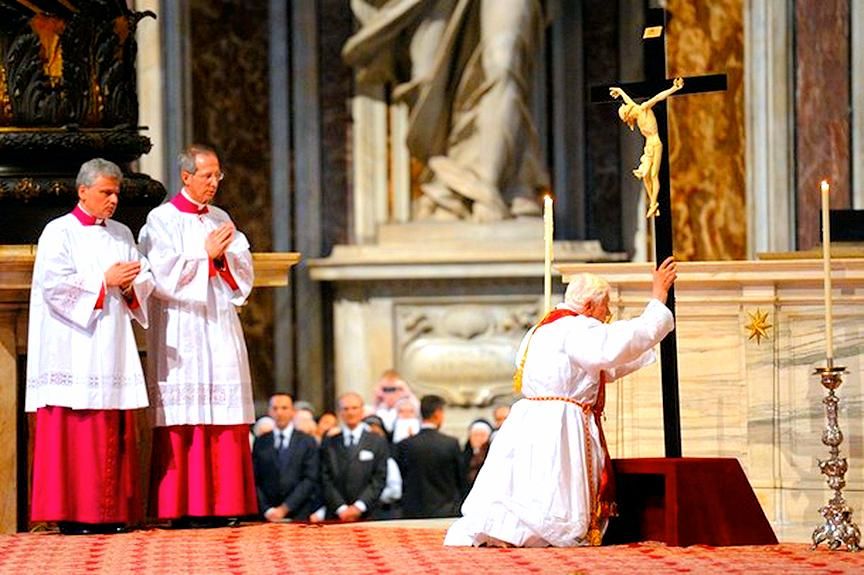 Communion
I could find no newsphotos taken of this part of the liturgy.
Communion
I could find no newsphotos taken of this part of the liturgy.
The Holy Father at the recessional.
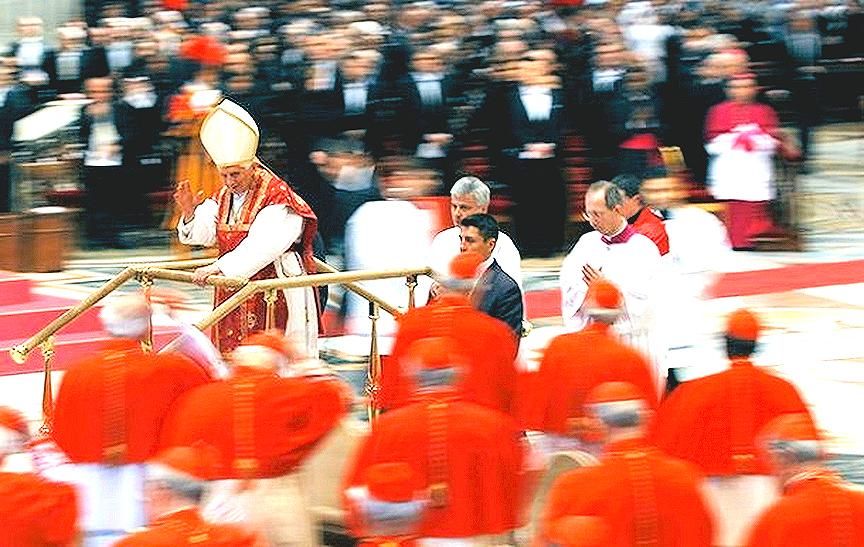
[Modificato da TERESA BENEDETTA 07/04/2012 12:45] |
| |
 07/04/2012 12:37 07/04/2012 12:37 |
|
| | | OFFLINE | | Post: 24.613
Post: 7.146 | Registrato il: 28/08/2005
Registrato il: 20/01/2009 | Administratore | Utente Master | |
|

 VIA CRUCIS
VIA CRUCIS
at the Colosseum
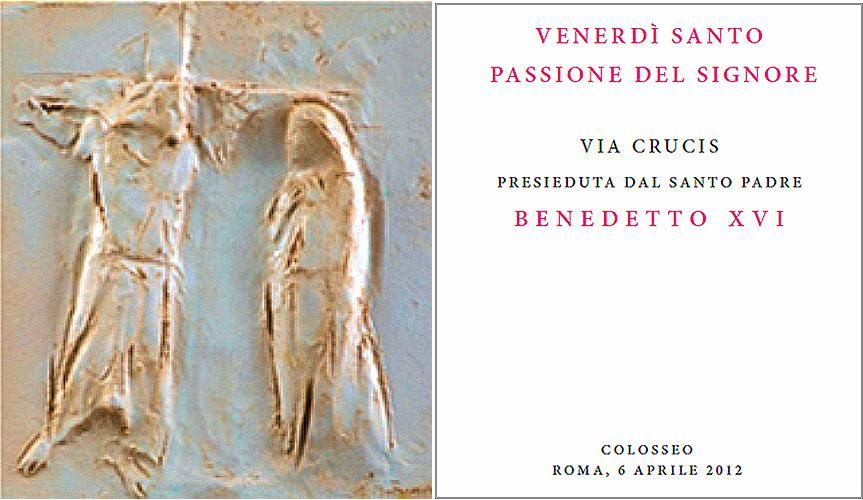 Libretto cover: From Stations of the Cross in bas-relief, by Benedetto Pietrogrande (Milan, 1938-), Chapel of the Focolari movement, Rocca di Papa.
Libretto cover: From Stations of the Cross in bas-relief, by Benedetto Pietrogrande (Milan, 1938-), Chapel of the Focolari movement, Rocca di Papa.
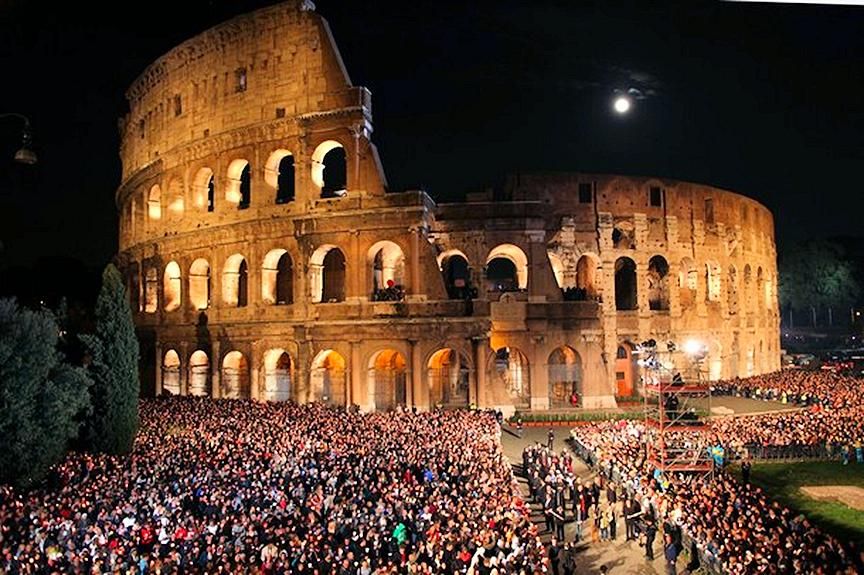
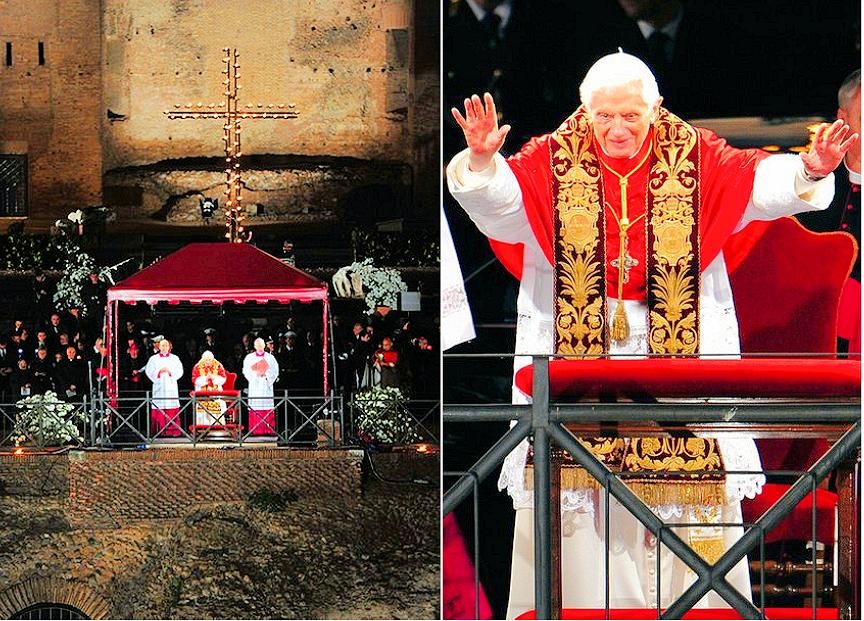
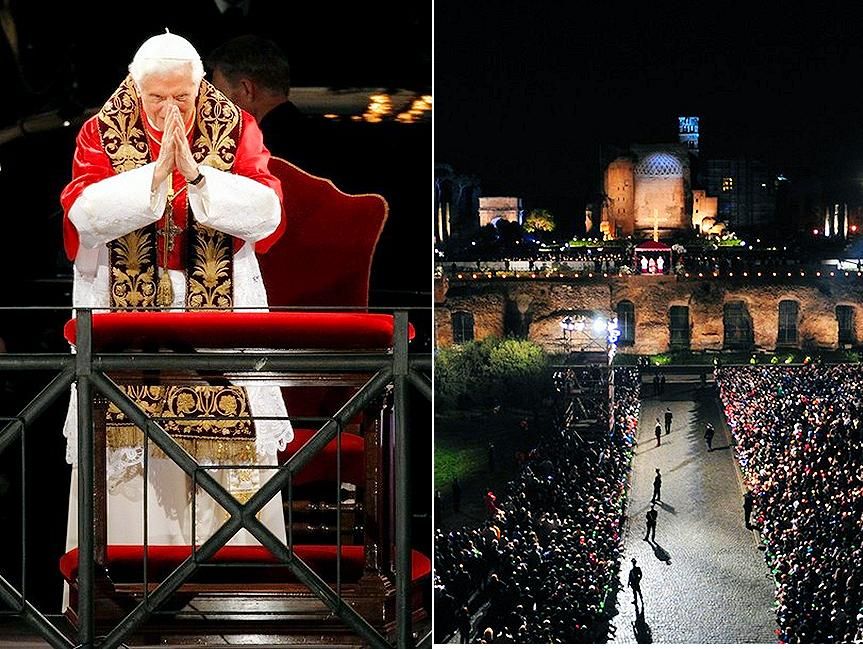 Pope says families in difficulty
Pope says families in difficulty
can draw strength from the Cross
by Salvatore Izzo

ROME, April 6 (Translated from AGI) - Benedict XVI presided at the annual Good Friday Way of the Cross at the Roman Colosseum Friday night, which was attended by some 20,000 pilgrims and broadcast worldwide on radio and TV.
The meditations and prayers for this year's ritual were written at the Pope's request by an octogenarian couple. Danilo and Anna Maria Zanzucchi, who were collaborators of the late Chiara Lubich, founder of the Focolari Movement, and who had founded within that ecclesial entity, the Famiglie Nuove (New Families) movement. Their text focused on problems of the family.
The Poipe who came from a two-hour Commemoration of the Passion liturgy at St. Peter's Basilica which ended two hours earlier, presided the Way of the Cross from a terrace on the Palatine Hill directly facing the Colosseum.
The Cross was successively carried through fourteen stations by Cardinal Agostino Vallini, the Pope's Vicar General for Rome; to Franciscan brothers from the Franciscan custody of the holy Land; and families from Italy, Ireland, Africa and Latin America; and lastly, handed on to the Holy Father.
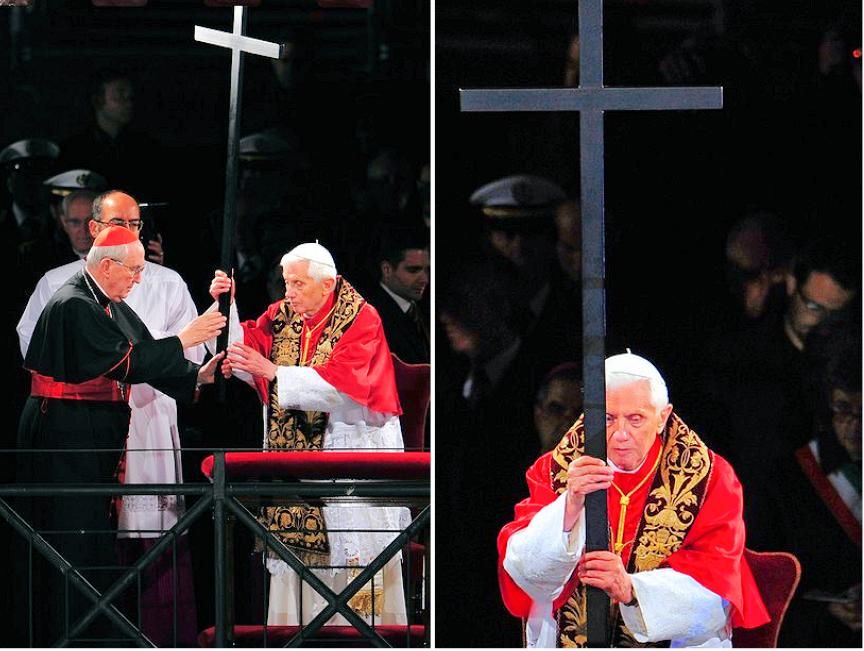
At the end of the 14 stations, the Pope delivered a brief reflection on the family.
“In times of trial and tribulation,” said Pope Benedict, “we are not alone; the family is not alone. Jesus is present with his love, he sustains them by his grace and grants the strength needed to carry on, to make sacrifices and to overcome every obstacle.”
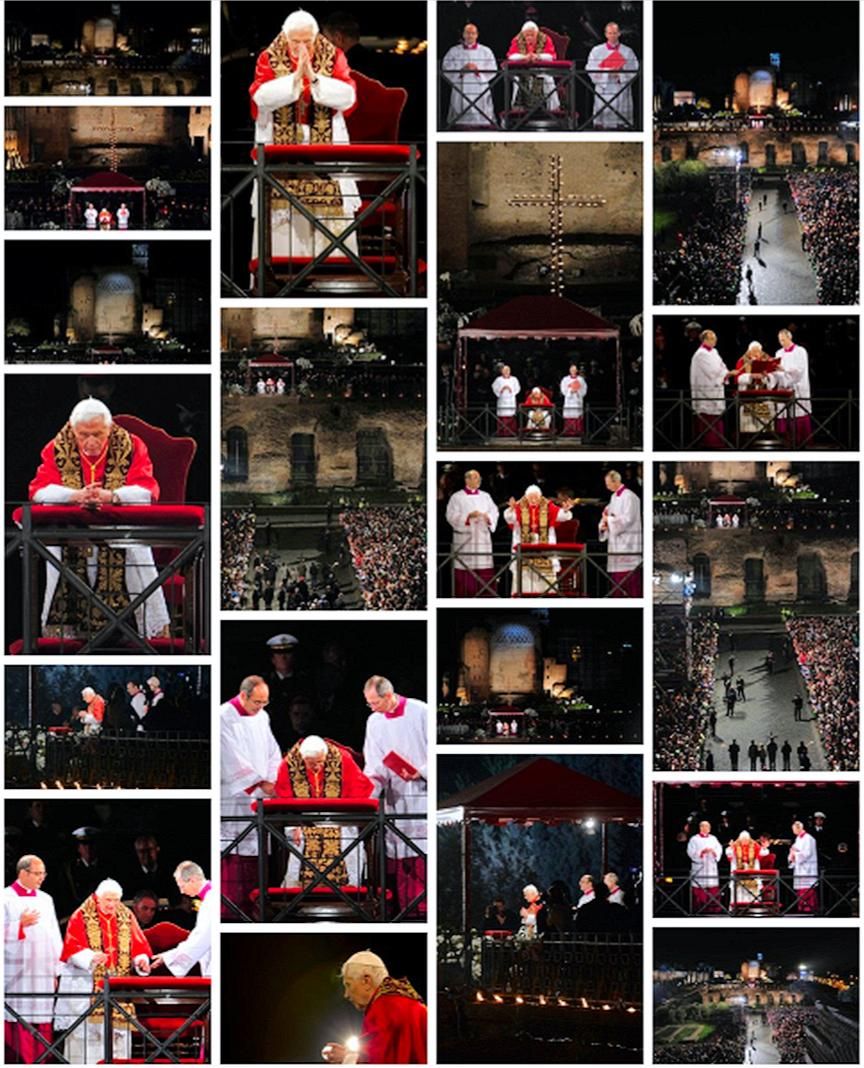
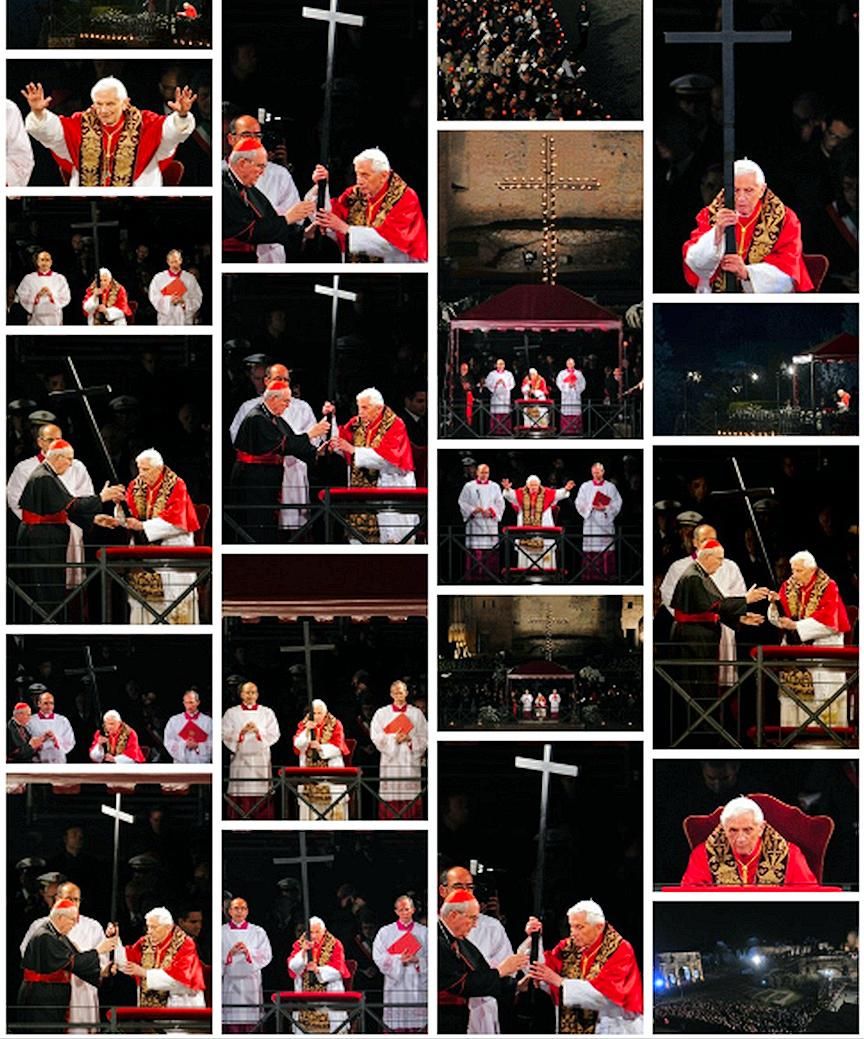
Here is the Vatican translation of the Holy Father's remarks and concluding prayer:
Dear Brothers and Sisters,
Once more in meditation, prayer and song, we have recalled Jesus’s journey along the way of the cross: a journey seemingly hopeless, yet one that changed human life and history, and opened the way to “new heavens and a new earth” (cf. Rev 21:1).
Especially today, Good Friday, the Church commemorates with deep spiritual union the death of the Son of God on the cross; in his cross she sees the tree of life, which blossoms in new hope.
The experience of suffering and of the cross touches all mankind; it touches the family too. How often does the journey become wearisome and difficult! Misunderstandings, conflicts, worry for the future of our children, sickness and problems of every kind. These days too, the situation of many families is made worse by the threat of unemployment and other negative effects of the economic crisis.
The Way of the Cross which we have spiritually retraced this evening invites all of us, and families in particular, to contemplate Christ crucified in order to have the strength to overcome difficulties. The cross of Christ is the supreme sign of God’s love for every man and woman, the superabundant response to every person’s need for love.
At times of trouble, when our families have to face pain and adversity, let us look to Christ’s cross. There we can find the courage and strength to press on; there we can repeat with firm hope the words of Saint Paul: “Who will separate us from the love of Christ? Will hardship, or distress, or persecution, or famine, or nakedness, or peril, or sword? … No, in all these things we are more than conquerors through him who loved us” (Rom 8:35,37).
In times of trial and tribulation, we are not alone; the family is not alone. Jesus is present with his love, he sustains them by his grace and grants the strength needed to carry on, to make sacrifices and to overcome every obstacle. And it is to this love of Christ that we must turn when human turmoil and difficulties threaten the unity of our lives and our families.
The mystery of Christ’s suffering, death and resurrection inspires us to go on in hope: times of trouble and testing, when endured with Christ, with faith in him, already contain the light of the resurrection, the new life of a world reborn, the passover of all those who believe in his word.
In that crucified Man who is the Son of God, even death itself takes on new meaning and purpose: it is redeemed and overcome, it becomes a passage to new life. “Unless a grain of wheat falls into the earth and dies, it remains just a single grain; but if it dies, it produces much fruit” (Jn 12:24).
Let us entrust ourselves to the Mother of Christ.
May Mary, who accompanied her Son along his way of sorrows, who stood beneath the cross at the hour of his death, and who inspired the Church at its birth to live in God’s presence, lead our hearts and the hearts of every family through the vast mysterium passionis towards the mysterium paschale, towards that light which breaks forth from Christ’s resurrection and reveals the definitive victory of love, joy and life over evil, suffering and death. Amen.
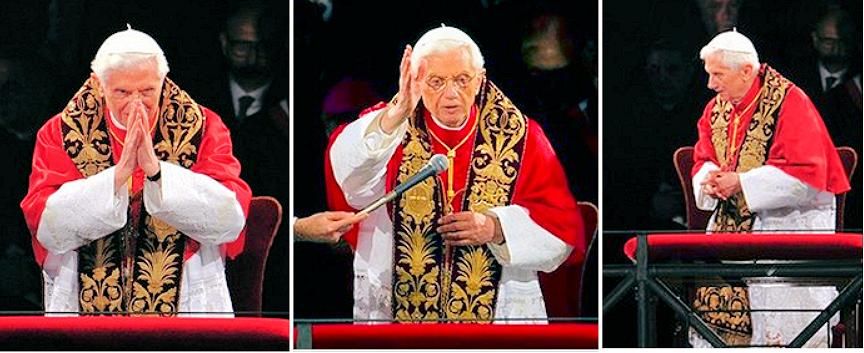 Way of the Cross for the family
Way of the Cross for the family

April 6, 2012
Thanks be to God for the Way of the Cross!
Among the different events and celebrations of Holy Week, probably the most touching, the one that most fascinates people’s hearts, is the Way of the Cross. It is not surprising.
Jesus has come to everyone, to men and women of every time, in their stories of suffering, whether it be free of guilt or the result of sin. And suffering is a fundamental, sometimes dominant part, of the experience of life.
Being able to bring it close to, and even to join it to the suffering of Christ, is an immense gift for everyone; being able to place it within a mystery open to hope and resurrection is a divine gift for believers.
This year, the idea of entrusting the meditations of the Pope’s Way of the Cross at the Colosseum to an elderly married couple is a wonderful and inspired one, and a significant step in the preparation for the next World Meeting of Families in Milan at the beginning of June.
The Church is constantly committed to defending the family, at a time when the contemporary mindset tends rather to belittle its value or even ridicule its loyalty and stability.
But we must also help the family by proposing a strong spirituality that can accompany it in times of difficulty, not only in material trouble or illness but also in those difficulties – sometimes profound and painful – between husband and wife, or when there are misunderstandings and rifts between parents and children, or when facing the solitude that comes at the death of a spouse.
Helping those who have had the courage to form a family to continue to always believe in the power of Love: this is the reason for making the Way of the Cross of the family, together with Christ, towards Easter.
The full English text of the meditations and prayers for this year's Colosseum Via Crucis has now been posted on:
http://www.vatican.va/news_services/liturgy/2012/documents/ns_lit_doc_20120406_via-crucis_en.html
Click on each station image to get the corresponding text.
[Modificato da TERESA BENEDETTA 07/04/2012 14:29] |
| |
 07/04/2012 13:32 07/04/2012 13:32 |
|
| | | OFFLINE | | Post: 24.614
Post: 7.147 | Registrato il: 28/08/2005
Registrato il: 20/01/2009 | Administratore | Utente Master | |
|
 An excerpt from
God and the World: A Conversation with Peter Seewald
An excerpt from
God and the World: A Conversation with Peter Seewald
(Ignatius Press, 2002), pages 332-36, 333.


April 6, 2012
Seewald: We are used to thinking of suffering as something we try to avoid at all costs. And there is nothing that many societies get more angry about than the Christian idea that one should bear with pain, should endure suffering, should even sometimes give oneself up to it, in order thereby to overcome it. "Suffering", John Paul II believes, "is a part of the mystery of being human." Why is this?
Cardinal Ratzinger: Today what people have in view is eliminating suffering from the world. For the individual, that means avoiding pain and suffering in whatever way. Yet we must also see that it is in this very way that the world becomes very hard and very cold.
Pain is part of being human. Anyone who really wanted to get rid of suffering would have to get rid of love before anything else, because there can be no love without suffering, because it always demands an element of self-sacrifice, because, given temperamental differences and the drama of situations, it will always bring with it renunciation and pain.
When we know that the way of love – this exodus, this going out of oneself – is the true way by which man becomes human, then we also understand that suffering is the process through which we mature.
Anyone who has inwardly accepted suffering becomes more mature and more understanding of others, becomes more human. Anyone who has consistently avoided suffering does not understand other people; he becomes hard and selfish.
Love itself is a passion, something we endure. In love experience first a happiness, a general feeling of happiness. Yet on the other hand, I am taken out of my comfortable tranquility and have to let myself be reshaped.
If we say that suffering is the inner side of love, we then also understand it is so important to learn how to suffer – and why, conversely, the avoidance of suffering renders someone unfit to cope with life. He would be left with an existential emptiness, which could then only be combined with bitterness, with rejection and no longer with any inner acceptance or progress toward maturity.
What would actually have happened if Christ had not appeared and if he had not died on the tree of the Cross? Would the world long since have come to ruin without him?
That we cannot say. Yet we can say that man would have no access to God. He would then only be able to relate to God in occasional fragmentary attempts. And, in the end, he would not know who or what God actually is.
Something of the light of God shines through in the great religions of the world, of course, and yet they remain a matter of fragments and questions. But if the question about God finds no answer, if the road to him is blocked, if there is no forgiveness, which can only come with the authority of God himself, then human life is nothing but a meaningless experiment.
Thus, God himself parted the clouds at a certain point. He turned on the light and has shown us the way that is the truth, that makes it possible for us to live and that is life itself.
Someone like Jesus inevitably attracts an enormous amount of attention and would be bound to offend any society. At the time of his appearance, the prophet from Nazareth was not only cheered, but also mocked and persecuted. The representatives of the established order saw in Jesus's teaching and his person a serious threat to their power, and Pharisees and high priests began to seek to take his life. At the same time, the Passion was obviously part and parcel of his message, since Christ himself began to prepare his disciples for his suffering and death. In two days, he declared at the beginning of the feast of Passover, "the Son of Man will be betrayed and crucified."
Jesus is adjusting the ideas of the disciples to the fact that the Messiah is not appearing as the Savior or the glorious powerful hero to restore the renown of Israel as a powerful state, as of old. He doesn't even call himself Messiah, but Son of Man.
His way, quite to the contrary, lies in powerlessness and in suffering death, betrayed to the heathen, as he says, and brought by the heathen to the Cross. The disciples would have to learn that the kingdom of God comes into the world in that way, and in no other.
A world-famous picture by Leonardo da Vinci, the Last Supper, shows Jesus's farewell meal in the circle of his twelve apostles. On that evening, Jesus first of all throws them all into terror and confusion by indicating that he will be the victim of betrayal. After that he founds the holy Eucharist, which from that point onward has been performed by Christians day after day for two thousand years.
"During the meal," we read in the Gospel, "Jesus took the bread and spoke the blessing; then he broke the bread, shared it with the disciples, and said: Take and eat; this is my body. Then he took the cup, spoke the thanksgiving, and passed it to the disciples with the words: Drink of this, all of you; this is my blood, the blood of the New Covenant, which is shed for you and for many for the forgiveness of sins. Do this in remembrance of me."
These are presumably the sentences that have been most often pronounced in the entire history of the world up till now. They give the impression of a sacred formula.
They are a sacred formula. In any case, these are words that entirely fail to fit into any category of what would be usual, what could be expected or premeditated. They are enormously rich in meaning and enormously profound.
If you want to get to know Christ, you can get to know him best by meditating on these words, and by getting to know the context of these words, which have become a sacrament, by joining in the celebration. The institution of the Eucharist represents the sum total of what Christ Is.
Here Jesus takes up the essential threads of the Old Testament. Thereby he relies on the institution of the Old Covenant, on Sinai, on one hand, thus making clear that what was begun on Sinai is now enacted anew: The Covenant that God made with men is now truly perfected.
The Last Supper is the rite of institution of the New Covenant. In giving himself over to men, he creates a community of blood between God and man.
On the other hand, some words of the prophet Jeremiah are taken up here, proclaiming the New Covenant. Both strands of the Old Testament (Law and prophets) are amalgamated to create this unity and, at the same time, shaped into a sacramental action. The Cross is already anticipated in this.
For when Christ gives his Body and his Blood, gives himself, then this assumes that he is really giving up his life. In that sense, these words are the inner act of the Cross, which occurs when God transforms this external violence against him into an act of self-donation to mankind.
And something else is anticipated here, the Resurrection. You cannot give anyone dead flesh to eat. Only because he is going to rise again are his Body and his Blood new. It is no longer cannibalism but union with the living, risen Christ that is happening here.
In these few words, as we see, lies a synthesis of the history of religion—of the history of Israel's faith, as well as of Jesus' own being and work, which finally becomes a sacrament and an abiding presence. ...
The soldiers abuse Jesus in a way we can hardly imagine. All hatred, everything bestial in man, utterly abysmal, the most horrible things men can do to one another, is obviously unloaded onto this man.
Jesus stands for all victims of brute force. In the twentieth century itself we have seen again how inventive human cruelty can be; how cruelty, in the act of destroying the image of man in others, dishonors and destroys that image in itself.
The fact that the Son of God took all this upon himself in exemplary manner, as the "Lamb of God", is bound to make us shudder at the cruelty of man, on one hand, and make us think carefully about ourselves, how far we are willing to stand by as cowardly or silent onlookers, or how far we share responsibility ourselves.
On the other side, it is bound to transform us and to make us rejoice in God. He has put himself on the side of the innocent and the suffering and would like to see us standing there too.
|
| |
 07/04/2012 14:12 07/04/2012 14:12 |
|
| | | OFFLINE | | Post: 24.615
Post: 7.148 | Registrato il: 28/08/2005
Registrato il: 20/01/2009 | Administratore | Utente Master | |
|
 How MSM reported the Pope's
How MSM reported the Pope's
homily on priestly disobedience -
and how they missed the point
By Catherine Harmon

April 5, 2012
“Pope denounces dissident priests
who question church teaching
on celibacy, ordaining women”
“Pope assails ‘disobedience’ among priests”
“Pope Benedict XVI slams priests”
“Pope rips into dissident priests”
Glancing over thes headlines about Pope Benedict’s Holy Thursday homily, one can’t help but notice the fiery — even violent — language used to describe the Holy Father’s words. But was he really so scathing in his remarks?
Yes and no.
Benedict’s homily is about authentic renewal and the priest’s conforming himself to Christ—fittingly, because Holy Thursday marks Jesus’s institution of the priesthood at the Last Supper.
Essential to the priest’s “configuration” to Christ is obedience, says Benedict. To illustrate his point, the Holy Father offers an example of what a lack of obedience looks like — specifically, a group of Austrian priests who have made a public “Call to Disobedience,” protesting Church teaching on women’s ordination and priestly celibacy, among other things. [Not just protesting, but pushing changes that will allow certain practices the Church has never adopted in 2000 years, and threatening to put them into effect themselves unless the Church instititutes these 'reforms'.]
Benedict allows that it is possible these protesting priests “are motivated by concern for the Church, that they are convinced that the slow pace of institutions has to be overcome by drastic measures, in order to open up new paths and to bring the Church up to date.”
But he rejects the notion that their blatant disobedience is the way to achieve these goals, asking, “Do we sense here anything of that configuration to Christ which is the precondition for all true renewal, or do we merely sense a desperate push to do something to change the Church in accordance with one’s own preferences and ideas?”
This explicit, high-profile critique of a specific group of people is unusual for Benedict, especially in the context of a homily — so headlines bringing this aspect of the Pope’s remarks to the fore are not completely unwarranted.
But focusing entirely upon his criticisms (and characterizing him as “denouncing,” “assailing,” “ripping into,” etc.) misses the Pope’s larger point. He’s not just calling out a group of troublesome rabble-rousers; he’s talking about the very heart of the priesthood:
Two things, above all, are asked of us: there is a need for an interior bond, a configuration to Christ, and at the same time there has to be a transcending of ourselves, a renunciation of what is simply our own, of the much-vaunted self-fulfilment.
We need, I need, not to claim my life as my own, but to place it at the disposal of another – of Christ. I should be asking not what I stand to gain, but what I can give for him and so for others.
“A priest never belongs to himself,” Benedict says later in his homily. Total consecration to Christ, and service to his Church, is the essence of the priesthood: “We preach not private theories and opinions, but the faith of the Church, whose servants we are.”
Obedience and conformity to Christ does not exclude authentic renewal, however:
Let us ask again: do not such reflections serve simply to defend inertia, the fossilization of traditions? No. Anyone who considers the history of the post-conciliar era can recognize the process of true renewal, which often took unexpected forms in living movements and made almost tangible the inexhaustible vitality of holy Church, the presence and effectiveness of the Holy Spirit. And if we look at the people from whom these fresh currents of life burst forth and continue to burst forth, then we see that this new fruitfulness requires being filled with the joy of faith, the radicalism of obedience, the dynamic of hope and the power of love.
Apart from Ms. Harmon and Father Z, who immediately posted the text of the Pope's homily and offered some comments, it is actually quite disappointing that no one else in the Anglophone Catholic blogosphere has picked up so far on this very significant speech... It also strikes me that it's about time someone put together an English anthology of Benedict XVI's homilies on the priesthood and the episcopate over the past seven years. A Curial prelate did this for the Italian originals in two volumes published in 2007 and 2008 until he was, unfortunately, secretly filmed meeting a homosexual in his Curial office, in one of the earliest true 'scandals' during this Pontificate when, curiously, come to think of it, no one laid the blame on Benedict XVI!
|
| |
 07/04/2012 16:23 07/04/2012 16:23 |
|
| | | OFFLINE | | Post: 24.616
Post: 7.149 | Registrato il: 28/08/2005
Registrato il: 20/01/2009 | Administratore | Utente Master | |
|
 I must admit that I have not paid enough attention on this Forum to the sermons of the Preacher of the Pontifical Household, Fr. Raniero Cantalamessa, who delivers five important sermons in Lent for the Holy Father and the Roman Curia - the four Lenten sermons on for four consecutive Fridays in the second-to the fifth weeks of Lent at the Redemptoris Mater chapel of the Apostolic Palace, and the homily at the Good Friday liturgy in St. Peter's Basilica.
I must admit that I have not paid enough attention on this Forum to the sermons of the Preacher of the Pontifical Household, Fr. Raniero Cantalamessa, who delivers five important sermons in Lent for the Holy Father and the Roman Curia - the four Lenten sermons on for four consecutive Fridays in the second-to the fifth weeks of Lent at the Redemptoris Mater chapel of the Apostolic Palace, and the homily at the Good Friday liturgy in St. Peter's Basilica.
This year, Vatican Radio even provided an immediate English translation of his Good Friday homily:
www.radiovaticana.org/en1/Articolo.asp?c=578071
In 2010, Fr. Cantalamesa created headlines full of outrage when he recounted in his Good Friday homily that a Jewish friend wrote him to say that the media assaults on the Church and the Pope over the sex abuses committed by some priests reminded him of the anti-Jewish propaganda in Nazi Germany before World War II.
This year, an Italian news agency finds a topical reference worked into the Franciscan theologian's Good Friday homily this year.
The Orlandi case laps at
Vatican's Holy Week observance
Papal preacher refers to 'anonymous crimes'
and 'unresolved cases' in Good Friday homily

VATICAN CITY, April 6 (Translated from TMNews) - The Emanuela Orlandi case turned up at the Vatican today in the midst of the commemoration of the Lord's Passion.
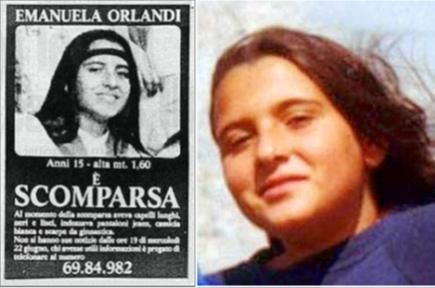 
Even if he couched it in general terms, the Preacher of the Pontifical Household, Fr. Raniero Cantalamessa, spoke to the Pope and the Good Friday congregation at St. Peter's about 'anonymous crimes (and) unresolved cases that take place even in our own country".
He said this after speaking of the 'sorrow of innocent children', and went on to call on 'responsible persons' to 'come out in the open', not to 'carry their secrets to the grave' and to 'confess their sins' because 'the Italian people are not unforgiving to those who ered but who acknowledge the bad they have caused'.
Avducted in 1983, Emanuela Orlandi, then 15, daughter of an employee in the Prefecture of the Pontifical Household and a Vatican citizen, has been for three decades at the center of one of the most intractable unsolved cases in Italian history.
Her brother Pietro recently published an interview book with newsman Fabrizio Peronaci entitled Mia sorella Emanuela (My sister Emanuela) in which he seeks to have light shed on the cold case.
Orlandi himself revived public interest in the case by launching an online petition to Benedict XVI - signed by some 70,000 Italians - asking him to "do everything humanly possible to ascertain the truth about what happened to his Vatican compatriot Emanuela Orlandi".
Pietro says he is hopeful because Benedict XVI has been engaged in bringing about transparency in Vatican affairs, in matters such as financial operations and the sex abuse cases, and therefore, could also contribute to uncover facts about his sister's disappearance.
Lately, the former mayor of Rome Walter Veltroni, now head of the center-left Partito Democrata, demanded in Parliament that the Vatican explain why a notorious Mafia chief Renatino de Pedis believed linked to the Orlandi disappearance was buried in the Roman church of Sant'Apollinare, near where, by coincidence, Orlandi was last seen apparently waiting for a bus before she was abducted. Veltroni engaged the current Interior Minister about the issue at question time in the Italian House of Deputies. [This seems like political opportunism because Veltroni was mayor of Rome at the time the Mafia lord was buried in Sant'Apollinare. Why did he not question it at the time? And what would the current Interior Minister say about a case that is 29 years old when suddenly questioned about it in Parliament?]
[NB: The Mafia connection is that De Pedis was thought to have masterminded the abduction to use the girl as a pawn, because her father was suspected to have come upon documents regarding links between the Mafia and the authorities at the Vatican financial institution IOR relative to the collapse of the Banco Ambrosiano bank in 1982.]
Also in recent days, a Roman prosecutor had openly said that 'someone in the Vatican knows the truth" about Orlandi's disappearance but is not talking. Since then, however, a new chief prosecutor, Giuseppe Pignatone, issued a statement saying that "every new initiative and proceeding on the case of Emanuela Orlandi will be directed and coordinated by Italian federal prosecutors, who have taken the responsibility for the district's anti-Mafia operations".
[I always thought that the investigation should really be in the hands of the Italians, specifically Rome police, because the crime happened in Rome, not at the Vatican, and because the Vatican police really are not equipped for criminal investigation and prosecution.]
There has been no official comment so far from the Vatican. But Cardinal Giovanni Battista Re, who was Deputy Secretary of State for General Affairs at the time of the abduction, told Corriere della Sera that "If anyone in the Vatican knew anything about the case, they would have said so already".
But today, the Preacher of the Pontifical Household seemed to address the issue in this passage of his homily, which comes after he speaks of the good thief who was crucified alongside Jesus:
How many atrocious crimes in recent times remain anonymous, how many unresolved cases exist! The good thief launches an appeal to those responsible: do like me, come out into the open, confess your fault; you also will experience the joy I had when I heard Jesus’ word: “”today you will be with me in Paradise!” (Luke 23:43).
How many confessed offenders can confirm that it was also like this for them: that they passed from hell to heaven the day that they had the courage to repent and confess their fault. I have known some myself. The paradise promised is peace of conscience, the possibility of looking at oneself in the mirror or of looking at one’s children without having to have contempt for oneself.
Do not take your secret to your grave; it would procure for you a far more fearful condemnation than the human. Our people are not merciless with one who has made a mistake but recognizes the evil done, sincerely, not just for some calculation. On the contrary! They are ready to be merciful and to accompany the repentant one on his journey of redemption...
[Modificato da TERESA BENEDETTA 07/04/2012 16:24] |
| |
 07/04/2012 17:34 07/04/2012 17:34 |
|
| | | OFFLINE | | Post: 24.617
Post: 7.150 | Registrato il: 28/08/2005
Registrato il: 20/01/2009 | Administratore | Utente Master | |
|
 Holy Saturday, April 7
Holy Saturday, April 7
 Greek Orthodox icons: From left, Jesus is prepared for burial, with the Magdalene, the Virgin Mary, the Apostle John and Joseph of Arimathea; other icons show Jesus's descent to Hades.
Greek Orthodox icons: From left, Jesus is prepared for burial, with the Magdalene, the Virgin Mary, the Apostle John and Joseph of Arimathea; other icons show Jesus's descent to Hades.
Holy Saturday is celebrated with elaborate rituals in the Orthodox Church.
Let us return once more to the night of Holy Saturday. In the Creed we say about Christ’s journey that he “descended into hell.” What happened then?
Since we have no knowledge of the world of death, we can only imagine his triumph over death with the help of images which remain very inadequate.
Yet, inadequate as they are, they can help us to understand something of the mystery. The liturgy applies to Jesus’ descent into the night of death the words of Psalm 23[24]: “Lift up your heads, O gates; be lifted up, O ancient doors!”
The gates of death are closed, no one can return from there. There is no key for those iron doors. But Christ has the key. His Cross opens wide the gates of death, the stern doors. They are barred no longer. His Cross, his radical love, is the key that opens them. The love of the One who, though God, became man in order to die – this love has the power to open those doors. This love is stronger than death.
The Easter icons of the Oriental Church show how Christ enters the world of the dead. He is clothed with light, for God is light. “The night is bright as the day, the darkness is as light” (cf. Ps 138[139]12).
- Benedict XVI, Easter Vigil homily, 2007
Tonight the Holy Father presides at
EASTER VIGIL MASS
21:00 St. Peter's Basilica
[Modificato da TERESA BENEDETTA 07/04/2012 17:36] |
| |
|
|
|
|